News
From November 19 through 23, LSU archaeologists shared insights on their ongoing research at the Annual Meeting of the American Anthropological Association held in New Orleans.
Doctoral student Kelvin Asare prepared a poster entitled "Archaeological Exploration of Nsakye Through Co-creation and Community Engagement" in which he summarized the results of his 2025 field season in Ghana.
Master student Joseph Petersen shared insights of his thesis work in a poster entitled "Assembling Experience: An Archaeological Case Study from the Ancient Andes."
David Chicoine, in collaboration with Matt Helmer and Jeisen Navarro, crafted a poster entitled "Ruins-as-Ghosts, Ruins-as-Cemeteries: Placemaking and Necropolitics in Late Horizon Samanco, Nepeña Valley, North-Central Coast of Peru."
Congratulations to all for contributing to the success of the event!
Congratulations to Cam Crooks on the successful defense of a thesis entitled "Gendered Changes in Stature in Northamptonshire from the Roman to the Medieval Period." Cam's research, under the supervision of a committee composed of David Chicoine, Kristine DeLong, Teresa Wilson and Maribel Dietz and in close collaboration with archaelogists from the University of Leceister, explores longitudinal patterns of statures from the Roman through the Medieval periods in England as estimated through the measurements of femurs from archaeological contexts.
Cam is currently completing a dual bachelor degree in history and anthropology and plans on pursuing his interests in bioarchaeology, isotopic analyses, and historical archaeology in graduate school next year.
G&A graduate students Conan Mills and Steve Treloar shared insights from their research at the 81st Annual Meeting of the Southeastern Archaeological Conference (SEAC) held in Baton Rouge from November 5-8.
Conan presented, with G&A almunus and Kisatchie National Forest archaeologist Matt Helmer, a paper entitled "Between River and Upland: The Old LSU Site in Historical Context."
Steve, alongside Jonathan Paige, Ian Robicheaux and Chesney Kuper, talked on "Synthesizing Kisatchie National Forest Lithic Datasets for Regional Interpretation."
Congratulations to Conan, Steve, and all their collaborators for their wonderful work!
Congratulations to G&A alumni Drs. Elizabeth Cruzado Carranza and Jacob Warner their recent hire by the Department of Geography & Planning at Appalachian State University and relocation to Boone, North Carolina!
All the best in your exciting new adventures!
The Louisiana Public Broadcasting (PBS affiliate) interviewed archaeologists Matt Helmer and Conan Mills as part of a news piece reporting the archaeological excavations at the Old LSU Site in the Kisatchie National Forest, Pineville, LA.
The video reports on the preliminary results of the investigations, especially the discovery of an underground water cistern that was later reused as trash pit where the team recovered a number of significant artifacts including architectural ornaments.
Congratulations to the team for bringing new insights into the early history of LSU!
Congratulations Dr. Elizabeth Cruzado Carranza (PhD LSU 2021) on the recent publication of the chapter "Inusualmente monumental y complejo: La historia de Casma, el pequeño valle de las ruinas desconcertantes," which she co-authored with her Peruvian colleagues Augusto Bazán and Rafael Vega-Centeno.
The contribution was included in the collective Vida, Tierra y Agua: los paisajes humanos, ecológicos y arqueológicos en los Andes edited by Álvaro Higueras, Rafael Vega-Centeno and Viviana Siveroni published by the university press of the Pontificia Universidad Catolica del Peru in Lima.
¡Felicitaciones a tod@s!
In June and July 2025, Cam Crooks, who is pursuing dual degrees in Anthropology and History, joined two archaeology field schools in the UK. With the financial support of LSU Honors College, LSU Career Center, and the Benjamin A. Gilman Scholarship Program, Cam participated in the Irchester Field School ran by the University of Leicester and Northamptonshire's Archaeological Resource Centre where they helped excavate the outer suburb of the small Roman town as part of the Irchester (Northamptonshire) project. Cam helped clear and record Roman structures and deposits, assisted in environmental processing techniques utilizing flotation equipment, assisted in sorting through a Roman coin hoard of 2,000 coins while also engaging with the public teaching osteology, providing tours during the Northamptonshire Roman Festival, and assisting supervising children digging with the Young Archaeologists Club.
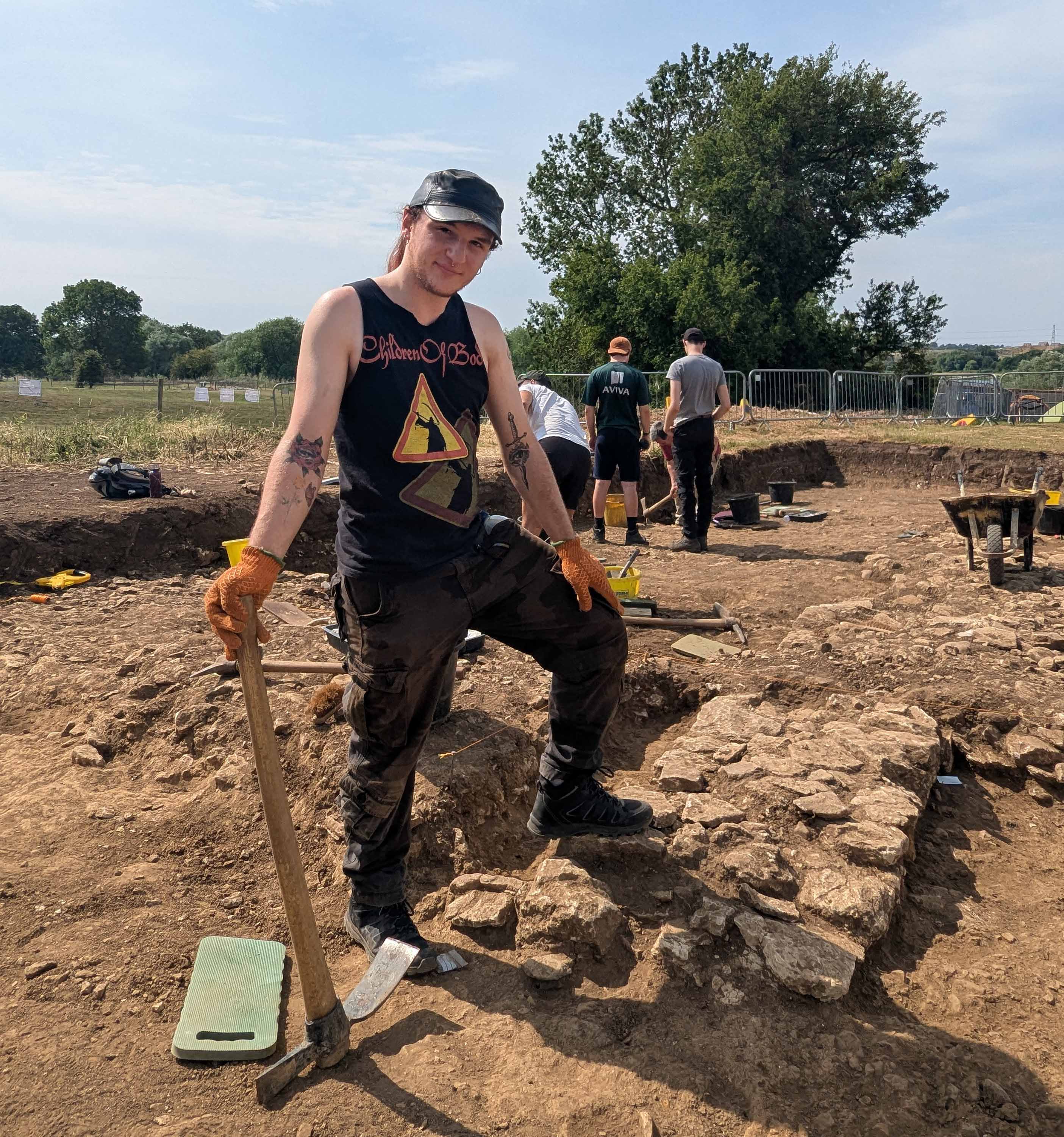 Cam Crooks at the Irchester Field School, Northamptonshire, UK. Photo credit: Cam
Crooks.
Cam Crooks at the Irchester Field School, Northamptonshire, UK. Photo credit: Cam
Crooks.
Cam also participated in the East Wear Bay (Kent) project with the Canterbury Archaeological Trust and the University of Kent where they assisted in excavating Iron Age remains near a Roman villa that has been facing coastal erosion and destruction due to its location along the cliffs. Cam used a total station to record finds and plot grids along the site in addition to using magnetometry and moisture resistivity surveys to collect geophysical data along the cliffs for future excavation plans.
The field experience will be foundational in Cam’s capstone (honors) thesis which, in collaboration with archaeologists at the University of Leicester and Northamptonshire’s Archaeological Resource Centre, will analyze femur remains from Northamptonshire dating from the Iron Age through to the Medieval era to understand potential changes in the quality of life and health of people.
Congratulations to Cam and all the team members for their productive and insightful excavations!
Over the course of five weeks in May-June 2025, G&A MA student Conan Mills and G&A affiliate faculty and LSU alumnus Dr. Matt Helmer (Heritage Program Manager, Kisatchie National Forest) led a group of students as part of an archaeology field school at the Old LSU Site (16RA49) in Pineville, LA.
The Old LSU Site is home to LSU’s original campus, which opened in 1860 after four years of tumultuous and interrupted construction. At the time, the school was known as the Louisiana Seminary of Learning and Military Academy. When Louisiana seceded from the Union in 1861, and with the beginning of the Civil War, the school closed, and the site was used as a hospital between 1863 and 1864 to treat wounded soldiers. Following the end of the Civil War, the original seminary reopened in 1865, but only to be destroyed by a fire in 1869, and then relocated to Baton Rouge, where it has been ever since.
The Old LSU Site is currently owned by the US Forest Service, and has never been archaeologically investigated. The archaeology field school provided students with the opportunity to get hands-on experience while working on an active research project. The course was designed to introduce students to the basics of archaeological surveys and excavations. Students took part in a systematic pedestrian survey to determine the extent of archaeological remains and the placement of excavation units.
 Kisatchie National Forest Heritage Manager Dr. Matt Helmer (right) supervising the
excavation of a shovel test at the Old LSU Site. Photo credit: Conan Mills..
Kisatchie National Forest Heritage Manager Dr. Matt Helmer (right) supervising the
excavation of a shovel test at the Old LSU Site. Photo credit: Conan Mills..
The team excavated 60 shovel tests and excavated nine larger units, sampling a large subsurface cistern, a kitchen refuse pit, the southeastern tower of the building, a professor’s residence, and other associated contexts. The excavations yielded thousands of artifacts dating before, during, and after the Seminary was in operation. Efforts documented the life of the people (including enslaved laborers) who built the seminary, cadets who attended the Seminary, and the professors and staff who helped keep the school running.
The excavations threw the team a few challenges and surprises. An underground cistern proved to be a challenge because of its depth and size, but it provided the most surprises of all the units, including previously unknown interior architectural details such as ornamented iron columns, decorated railings, and a large, engraved marble stone interpreted to be part of the original school entrance.
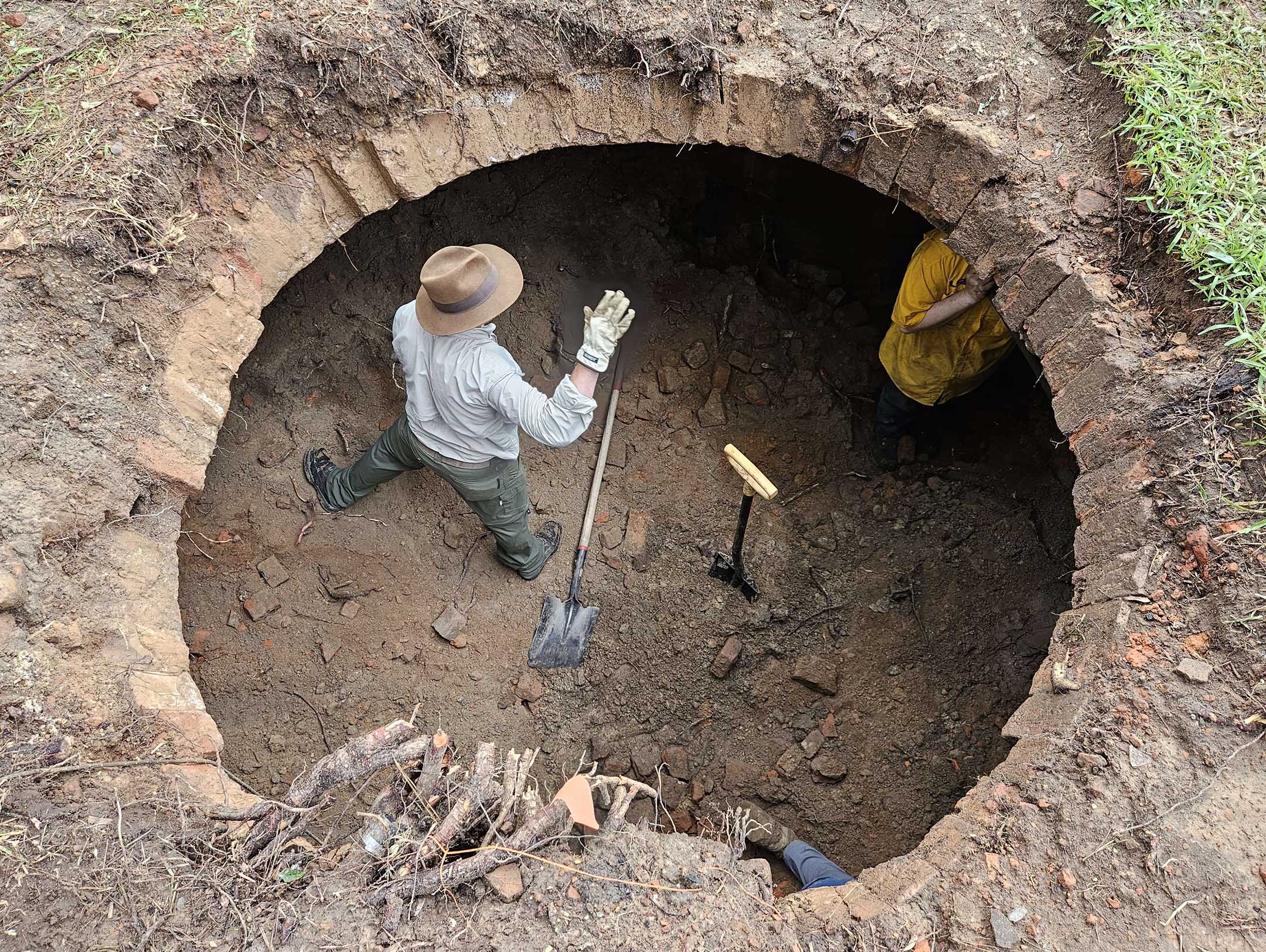 Underground cistern uncovered during archaeological excavations at the Old LSU Site.
Photo Credit: Conan Mills.
Underground cistern uncovered during archaeological excavations at the Old LSU Site.
Photo Credit: Conan Mills.
Analyses are still ongoing, but several of the artifacts offer material testimonies of life back in the 1850-1860s including bricks with enslaved laborers’ finger marks, inkwells and slate pencils evidencing academic activities, uniform buttons and weaponry, and pottery and glass domestic wares.
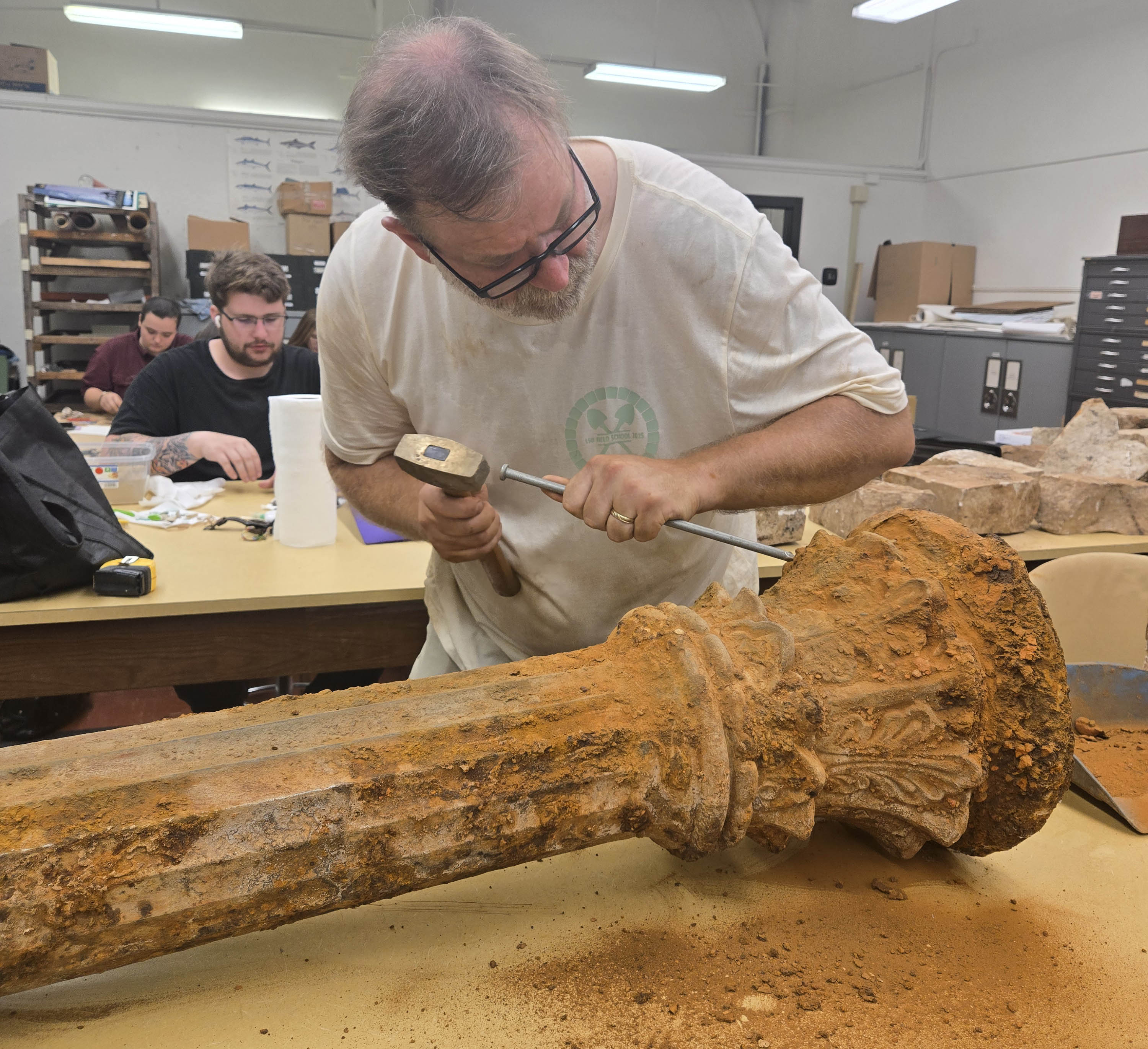 MA student Conan Mills cleaning an iron column recovered during archaeological excavations
at the Old LSU Site. Photo credit: Matt Helmer.
MA student Conan Mills cleaning an iron column recovered during archaeological excavations
at the Old LSU Site. Photo credit: Matt Helmer.
The team of G&A archaeologists and students also engaged with the public and raised awareness about the role of archaeology in preserving and interpreting Louisiana’s past. The project is part of Conan Mills’ thesis research documenting the early history of LSU, especially its architecture and vibrant social makeup, including traditionally underrepresented voices. The project will also form part of site interpretive and preservation plans being put together by Kisatchie National Forest and LSU. The LSU Military History Museum in Memorial Tower will feature a permanent exhibit of some of the key findings from the project as well, and will be open to the public.
Warm thanks to LSU's G&A department, R.C. West and R.J. Russell Graduate Student Research Award and the Kisatchie National Forest for the financial and logistical support, as well as to all the students and collaborators who took part in the excavations and the laboratory activities.
For more press coverage of the excavations, consult this article and video.
Congratulations to all team members on documenting LSU early history!
Congratulations to LSU alumna Dr. Kimberly Munro (PhD LSU 2018) on being awarded an Association of American University Women (AAUW) Postdoctoral Research Leave Fellowship for the academic year 2025-2026.
The AAUW award will provide Kimberly, who is currently holding a tenure-track position in the Department of Sociology & Anthropology at New Mexico Highlands University, crucial time off from her teaching duties to pursue her archaeological research in Peru and publication agenda.
The fellowship is a wonderful opportunity to advance Kimberly’s research interests in the anthropology of pilgrimage, shamanism, and religious syncretism and the creation and re-imagining of space, place and sacred landscapes.
For the last decade, Kimberly has been doing fieldwork in the Cosma community in the highland region of the Nepeña Valley, north-central Peru, where her team and collaborators have documented human occupations going back more than 5,000 years ago.
You can follow updates of Kimberly’s fascinating research on her website.
In June and July 2025, G&A doctoral student Kelvin Asare, with the financial support of the R.C. West and R.J. Russell Graduate Student Research Award, began preliminary archaeological fieldwork at Nsakye, a small community located in the Eastern Region of Ghana, some 35 km north of the capital Accra. While the region is one of the least archaeologically studied in Ghana, it offers great potential for understanding the complex history of West Africa, especially the Akwamu Empire (17th-18th centuries AD) and the European colonial presence.
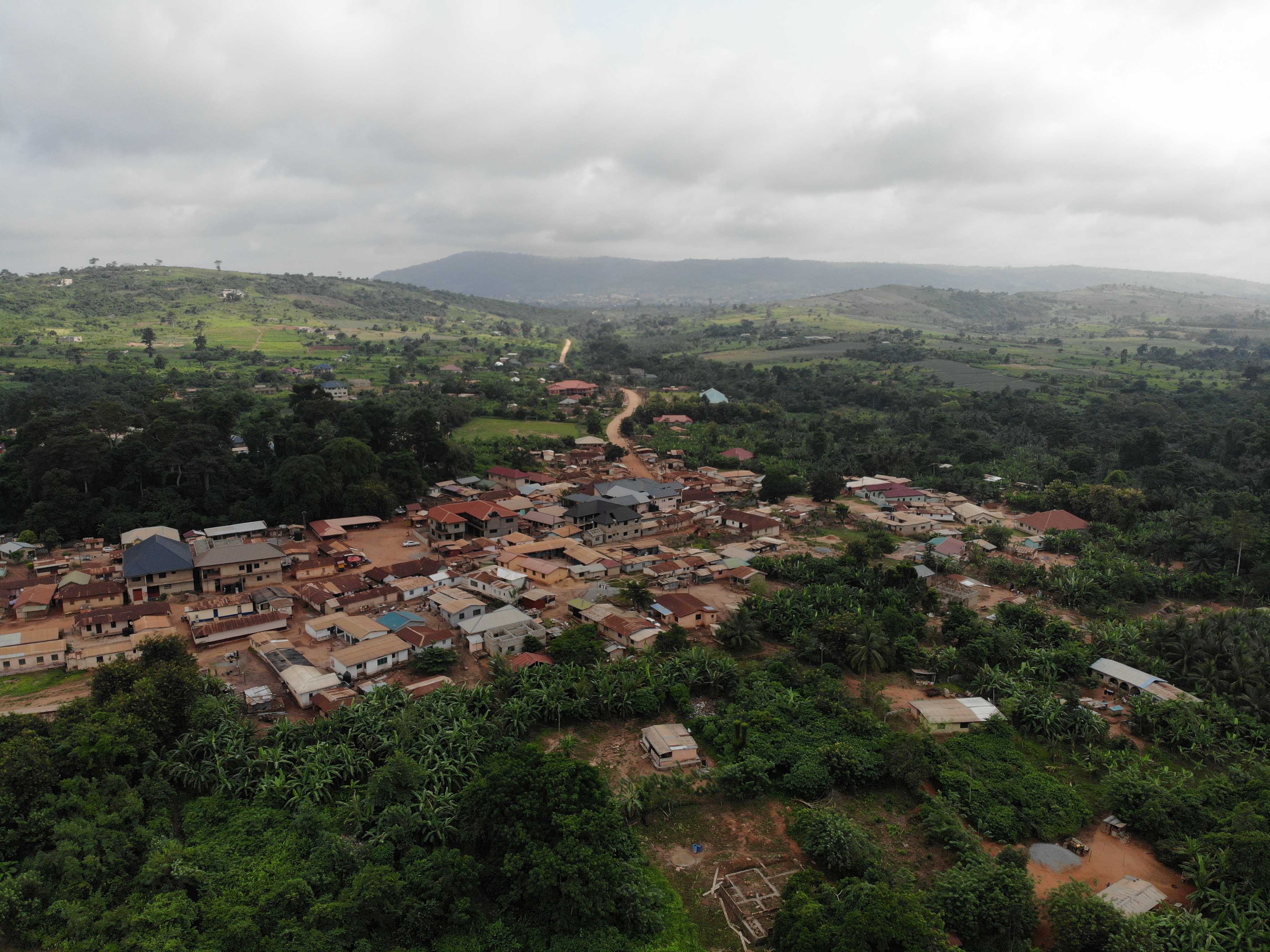 Drone view of Nsakye, Eastern Region of Ghana. Photo credit: Kelvin Asare.
Drone view of Nsakye, Eastern Region of Ghana. Photo credit: Kelvin Asare.
Kelvin’s team, composed of archaeologists and students from the University of Ghana (Kelvin’s alma mater), began collaborating with the local community. Following Ghanaian regulations as well as community protocol, the team was granted permission to undertake a pedestrian and drone survey of Nsakye, map the visible archaeological remains, and excavate four test pits.
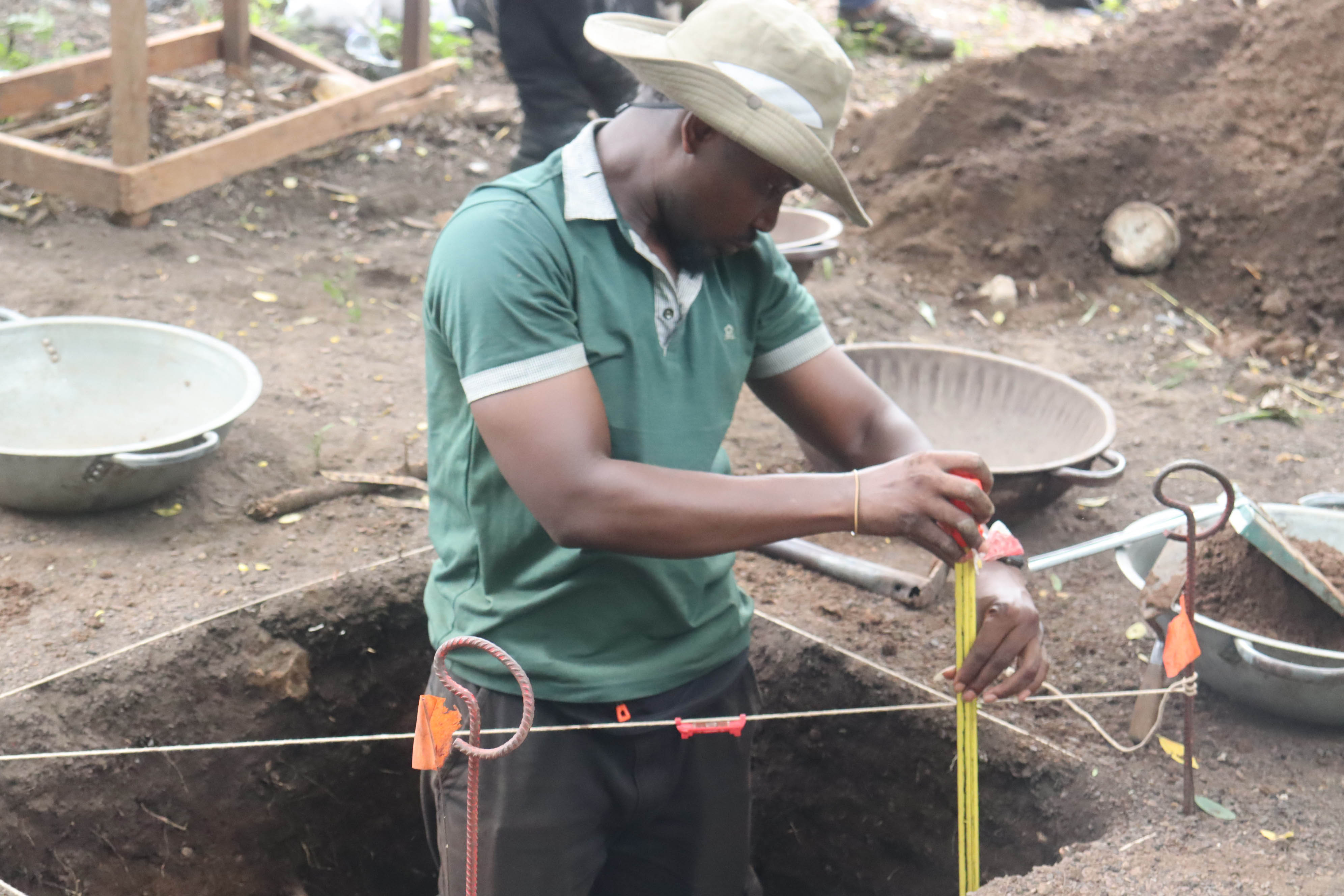 Kelvin Asare recording a stratigraphic profile in test unit at Nsakye. Photo credit:
Bismark Asamoah.
Kelvin Asare recording a stratigraphic profile in test unit at Nsakye. Photo credit:
Bismark Asamoah.
The preliminary fieldwork was a great success and yielded rich surface scatters of Indigenous and European artifacts, including pottery fragments, glasswares, smoking pipes, freshwater and marine shells, iron slags, and laterite. The test excavations, meanwhile, attested to the European influence in the area, as well as yielded additional evidence of metallurgy, an important local technology before and after the European presence.
Detailed analyses of the collections are ongoing and should bring more insights into the complex history and materiality of Nsakye’s past, as well as guide the next field season planned for 2026. Ultimately, Kelvin’s goal is to engage the community, foster the co-creation of cultural heritage through archaeology, and thus explore the implications of historical reconstructions in shaping Ghanaian identities.
Kelvin will share preliminary results of the Nsakye research at the upcoming meeting of the American Anthropological Association to be held in New Orleans in November.
Congratulations to Kelvin and all the team members and local collaborators for their wonderful and insightful work!
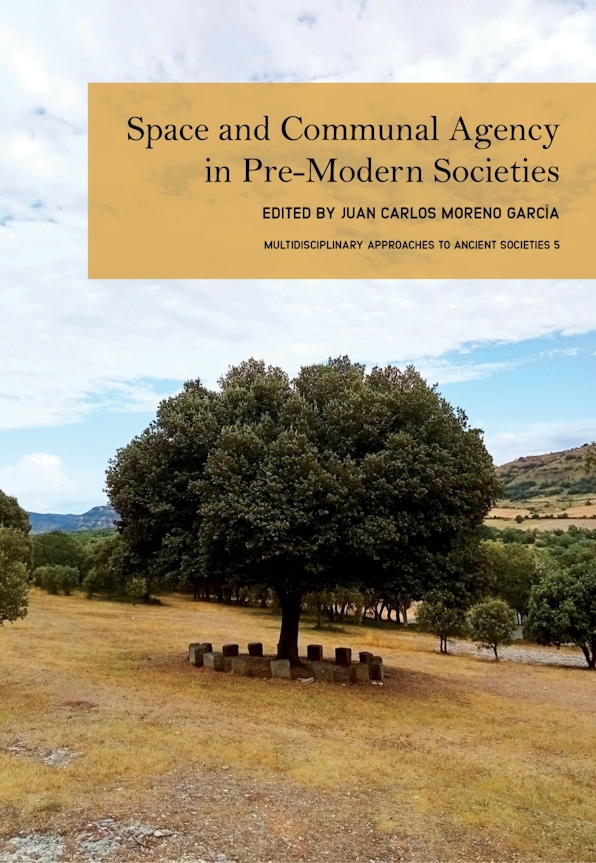
David Chicoine and Matt Helmer co-authored a chapter exploring the mortuary reuse of abandoned spaces in coastal Peru. The chapter, entitled "Real, Imagined, Vibrant: Ruins-as-Cemeteries in Ancient Coastal Peru," was included in the volume Space and Communal Agency in Pre-Modern Societies edited by Juan Caros Moreno García and published by Oxbow Books (Multidisciplinary Approaches to Ancient Societies Volume 5).
The essay moves beyond two persistent binaries in archaeological thinking: (1) one that revolves around the distinction between what we consider as animate and what we consider to be inert, and (2) the other between space as real and space as ideal. We frame our heterotopological approach to monumental ruins-as-cemeteries and present archaeological data that demonstrate the protentions and retentions of built settings through time.
The case study focuses on the mortuary reuse of the ruins of Caylán, north-central coast of Peru, during the Late Intermediate Period (1000-1470 CE). We suggest that ruins-as-cemeteries can be considered heterotopias that provided “counter-spaces,” potentially for different social segments, kin groups, and other formations who incorporated ancestral things into their mortuary life, thus contributing to the creation of alternative political messages.
Thanks to Juan Carlos for the kind invitation to contribute and congratulations to all authors for the wonderful collection of essays!
Congratulations to Dr. Amy Hernandez on her graduation from the doctoral program in anthropology!
Amy's dissertation, entitled "Osteon Analysis and Health Status at the Colonial Maya Site of Tipu, Belize" explored patterns of health disparities and inequalities as seen through a bioarchaeological lens of health defects and bone microstructure. Through the analysis of 200 rib fragments, Amy's research indicates that females, particularly those buried inside a colonial church, had higher annual rates of remodeling, indicating better health.
Congratulations to Julia Johnston for graduating from the MA program in anthropology!
Combining ethnographic interviews, the analysis of legal documentation, and a case of repatriation at LSU, Julia's thesis research compared the legal frameworks associated with the treatment of archaeological human remains in Peru and the United States.
Following graduation, Julia was hired as NAGPRA Assistant by the Texas Archeological Research Laboratory with the University of Texas at Austin.
Congratulations on completing the MA and the new job!

Congratulations to Álvaro Higueras, Rafael Vega-Centeno and Viviana Siveroni on their wonderful work in editing Vida, Tierra y Agua: los paisajes humanos, ecológicos y arqueológicos en los Andes, a collective currently in press with the Fondo Editorial PUCP in Lima.
The edited collection was inspired by geographer Paul Kosok's posthumous book Life, Land, and Water in Ancient Peru (1965), a landmark in landscape archaeology, the use of aerial imagery, and the study of water management in ancient times.
Hugo Ikehara-Tsukayama, David Chicoine, Jenna Hurtubise, Kimberly Munro and Marco Pfeiffer contributed the chapter "Comunidades y paisajes cambiantes del valle de Nepeña."
Drawing from the data from various field projects over the last two decades, our chapter provides an overview of the changing relationships between human societies and their landscapes in the Nepeña Valley over time.
¡Felicitaciones a tod@s!
On Tuesday April 29 (6pm CDT), I presented a public lecture as part of the LSU Science Café initiative held in person at the Varsity Theater in Baton Rouge.
The talk, entitled "Urban Living in Ancient, Violent Times: Archaeological Insights from Coastal Peru," leveraged evidence from my field research in the Nepeña Valley over the last 20 years. Focusing on the second half of the first millennium BCE, I explored how increased armed conflicts and violence shaped people's ways of life, including urban crowding and its material, spatial and cultural correlates.
Science Café is organized by LSU's Office of Research & Economic Development in partnership with Campus Federal Credit Union and WRKF.
Special thanks to Prosanta Chakrabarty, Holly Carruth, and Elsa Hahne with their help in organizing the event, as well as to everyone who attended!
Congratulations to Dr. Matt Helmer (MA LSU 2011) on the recent publication of his collaborative work on "Preserving coastal environments requires an integrated natural and cultural resources management approach" in PNAS Nexus.
The article, co-authored by Jayur Madhusudan Mehta, Elizabeth Chamberlain, Matthew Helmer, Elizabeth Haire, Mark D McCoy, Roy van Beek, Haizhong Wang, and Siyu Yu, examines the integration of various disciplines, including archaeology, environmental science, and land management policy, to tackle the management of cultural resources in coastal environments around the world.
Congratulations to all authors and collaborators for their inspiring and very important contribution!
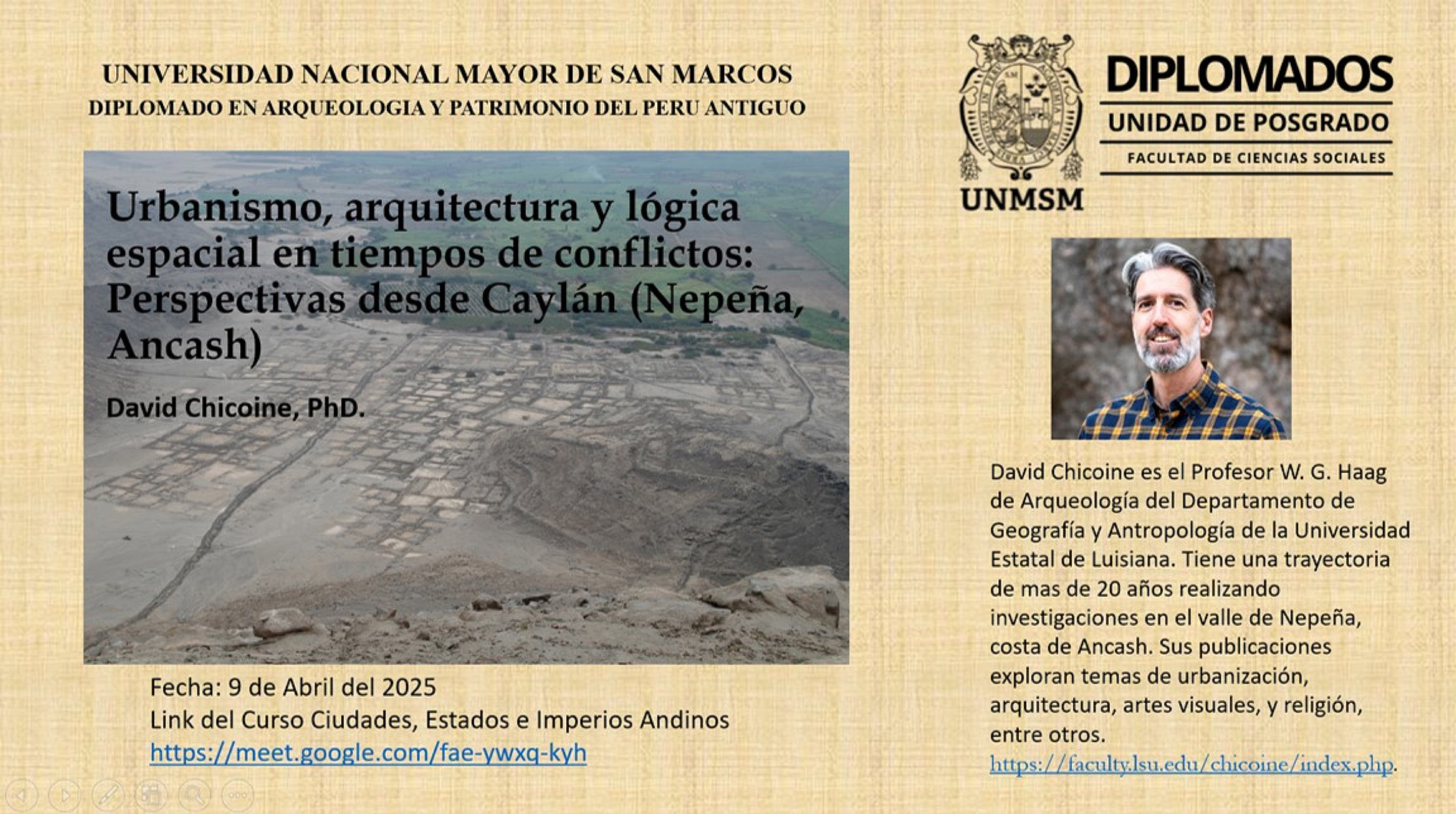
On Wednesday April 9 (7pm CDT), I presented a guest lecture in Dr. Gabriela Cervantes Quequezana's postgraduate seminar on "Ciudades, Estados e Imperios Antiguos" sponsored by the Universidad Nacional Mayor de San Marcos in Lima, Peru.
The talk leveraged data from archaeological research at Caylán (600-200 BCE) to explore architecture and the spatial logic of the agglomeration at a time of increased conflicts on the north-central coast of Peru.

Sacred Sovereigns: Art, Divinity and Rulership in the Ancient Americas, the latest issue of World Art, is now available online!
The collection, which is the outcome of a symposium held at the Sainsbury Research Unit of the University of East Anglia in October 2023, brings together eight contributions examining the visual and material expressions of divinity and authority over the last 3,000 years in Mesoamerica and the Andes.
The papers offer art historical, archaeological, and anthropological perspectives into the religious construction of political authority and the complex entanglements between the cultural, natural, and supernatural worlds, especially how different forces, spirits and other such "metapersons" can become sources of power.
Warm thanks to George F. Lau for leading the way and to all contributors for generously sharing insights from their research!

On Friday March 14 (3.30pm, HRK W130), Dr. Jacob Warner (Assistant Professor, SUNY Oneonta) shares insights from his ongoing research on "Surface Water Stable Isotope Analysis in Understudied Regions."
Dr. Warner, who studied in the Department of Geography & Anthropology between 2007 and 2021, is a geoarchaeologist and paleoclimatologist specializing in the study of marine shells as proxies for climate reconstructions and human-environmental relations.
Congratulations to Julia Johnston on the successful defense of her MA thesis. Under the guidance of a committee composed of David Chicoine, Ginesse Listi and Helena Fietz, Julia's work offers a comparative ethnographic analysis of the legal frameworks pertaining to the treatment of human skeletal remains in Peru and the US.
Pending minor revisions and approval by the graduate school, Julia is set to graduate in May with a MA degree.
Congratulations to Dr. Kenny Sutherland (PhD LSU 2024) on the recent publication of his article "Living Amongst the Ancient Tombs of Southern Osaka." Drawing from his experience in Japan, the article, published in the magazine Epoch, examines the phenomenology of ancient tombs (kofun) of the Mozu-Furuichi Kofun Group in southern Osaka Prefecture, focusing on how the monuments connect the modern population with their past, especially the Kofun Period (300–538 CE) and the Asuka Period (538–710 CE).
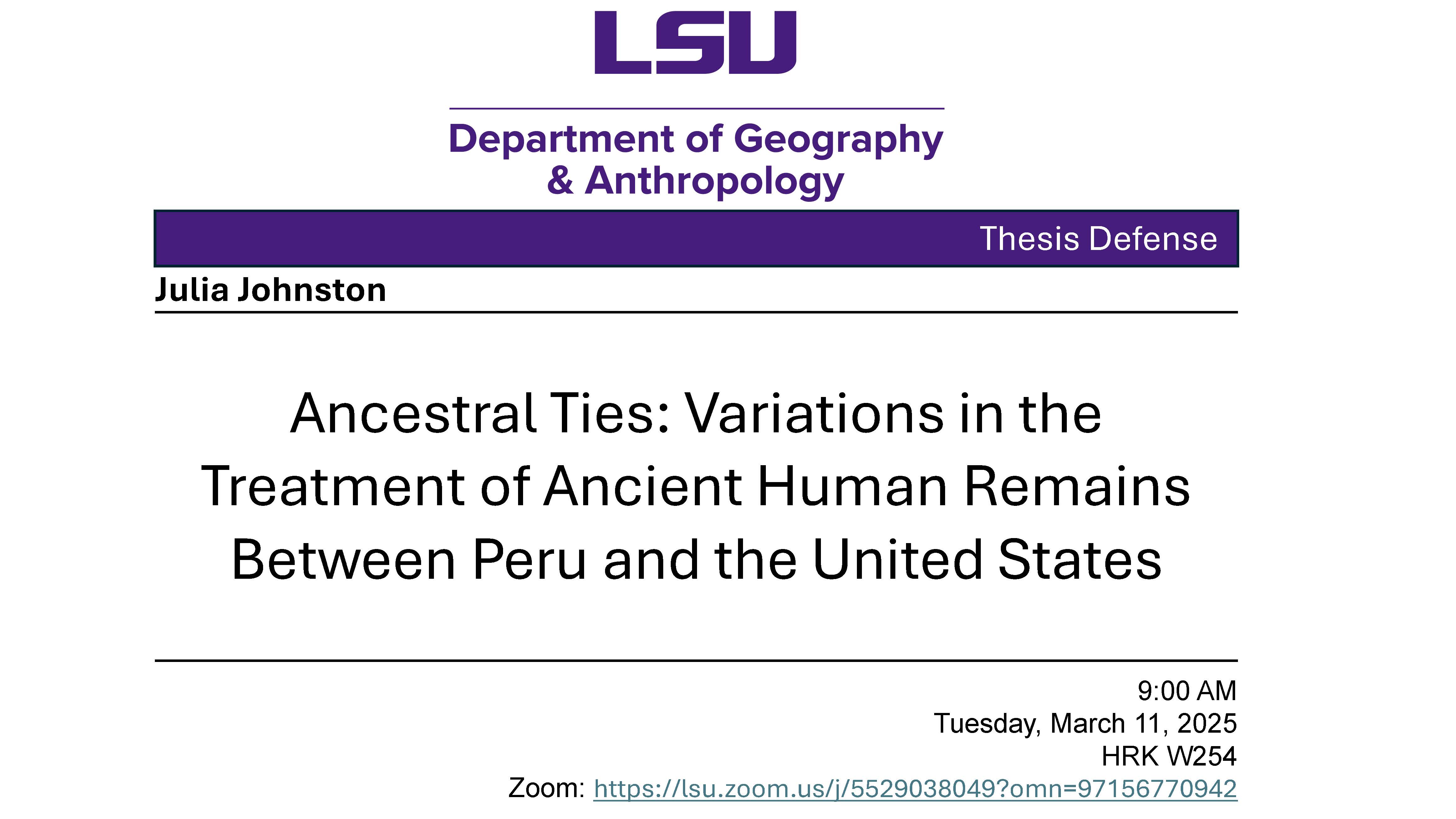
On March 11 (9am, HRK W254), anthropology graduate student Julia Johnston will defend her thesis entitled "Ancestral Ties: Variations in the Treatment of Ancient Human Remains Between Peru and the United States." Julia's research, under the supervision of a committee composed of David Chicoine, Ginesse Listi and Helena Fietz draws from her field, lab, and museum work in Peru and the US, as well as interviews with key actors.
Everyone is welcome to attend the public portion of the defense.
Congratulations to Conan Mills on winning second place in the 2024-2025 William G. Haag Graduate Student Conference Presentation Award sponsored by LSU's Department of Geography & Anthropology. Conan presented a multimodal poster at the 89th Annual Meeting of the Society for American Archaeology held in New Orleans in April 2024.
Conan's presentation, entitled "Digital Archaeology at Sites 16VN3504 and 16VN3508 in Western Louisiana: Digital Preservation in the Face of Climate Change," , entailed virtual reality "goggles" to enhance the traditional poster format, thus helping the audience to immerse themselves in Louisiana archaeology.
In collaboration with Dr. Matt Helmer of the US Forest Service at Kisatchie, Conan is currently developing a MA thesis project exploring the "Old LSU Site" in Pineville.
Congratulations to Amy Hernandez for successfully defending her doctoral dissertation! Pending revisions recommended by members of her evaluation committee and acceptance by the graduate school, Amy is now set to graduate in May 2025.
Congratulations to PhD candidate Corey Hoover on completing the general exams. Corey's dissertation work, under the supervision of a committee composed of David Chicoine, Kristine DeLong, Linda Hooper-Bui, and Nathalie Rademacher, explores human-camelid relations on the north coast of Peru.
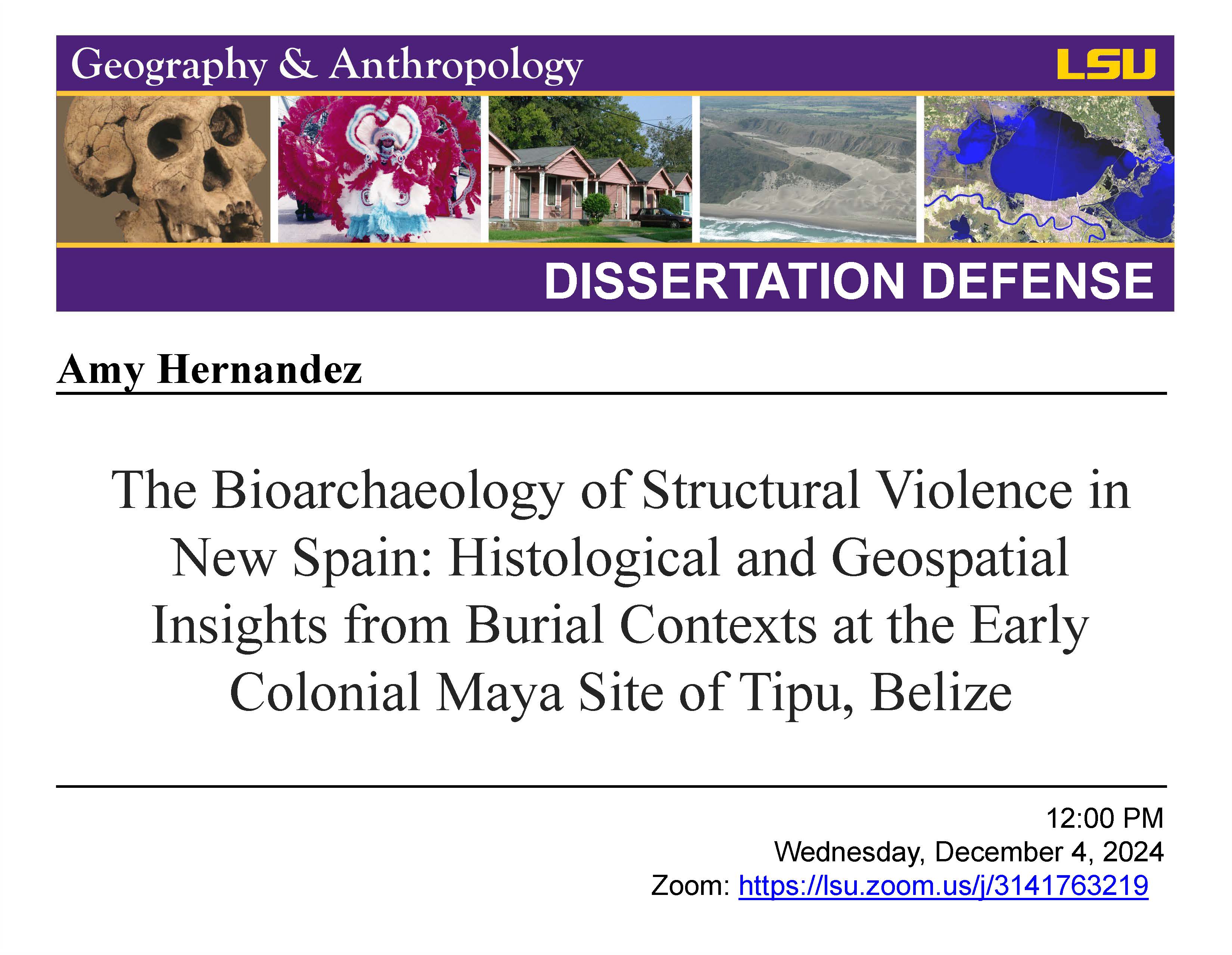
On Wednesday December 4 at noon, Amy Hernandez will defend her doctoral dissertation entitled “The Bioarchaeology of Structural Violence in New Spain: Histological and Spatial Insights from Burial Contexts at the Early Colonial Maya Site of Tipu, Belize.”
Under the supervision of a committee composed of David Chicoine, Heather McKillop, Teresa Wilson, Marie Danforth and Meredith Blackwell, Amy's dissertation examines the impact of colonialism and structural violence on the health and burial practices of Maya populations living on the Spanish colonial frontier in the 16th and 17th centuries.
Everyone is welcome to attend the public portion of the defense.
On Friday November 22 (3.30pm, Howe-Russell-Kniffen W130), Dr. Véronique Bélisle (Millsaps College) will visit our department to share insights from her recent archaeological excavations in the Cuzco region of Peru. Her talk will examine "State Expansion and Local Encounters: Negotiating Alliances in Pre-Inka Peru."
Dr. Bélisle is an anthropological archaeologist interested in the expansion of ancient states, especially the Wari state (600-1000 CE). Her research has been published in high quality peer-reviewed journals including Quaternary International, Ñawpa Pacha: Journal of Andean Archaeology, Journal of Archaeological Science: Reports, Cambridge Archaeological Journal, Journal of Archaeological Science, Latin American Antiquity, and Journal of Anthropological Archaeology.
The talk is free and everyone is welcome to attend!

David Chicoine and Matt Helmer co-authored a chapter exploring the mortuary reuse of abandoned spaces in coastal Peru. The chapter, entitled "Real, Imagined, Vibrant: Ruins-as-Cemeteries in Ancient Coastal Peru," is in press in the volume Space and Communal Agency in Pre-Modern Societies edited by Juan Carlos Moreno García and published by Oxbow Books (Multidisciplinary Approaches to Ancient Societies Volume 5). The book should be out in February 2025.
Many thanks to all our collaborators in Peru as well as to Juan Carlos Moreno García for the invitation to contribute and his wise editorial guidance.
Congratulations to Haley Stuckey (BA LSU 2023) on the online publication of her personal reflections on "Doing Archaeology of the Spiritual" at the St. James AME Zion Church in Ithaca, NY. The excavations are part of a public archaeological project sponsored by the Cornell Institute of Archaeology and Material Culture Studies where Haley is currently pursuing her MA studies.
Congratulations to James Steven "Steve" Treloar (MA LSU 2014) on his recent appointment as the Heritage Assistant Program Manager for the US Forest Service at Kisatchie National Forest in Pineville, LA!
Congratulations to Kelvin Asare on the recent publication of his article "New Approaches in Ghanaian Archaeology: Using GIS Resources to Assess the State of Archaeological Sites in Ghana" in Issue 101 of Nyame Akuma, the Bulletin of the Society of Africanist Archaeologists. The article reports on the results of Kelvin's master degree research in the Department of Archaeology and Heritage Studies at the University of Ghana, Legon.
Kelvin is currently a doctoral student in the Department of Geography & Anthropology at LSU.
Congratulations to Haley Stuckey who recently joined the graduate program at the Cornell Institute of Archaeology & Material Studies. Haley completed three bachelors at LSU (BA in Anthropology, BA in English [Creative Writing], BIS [Philosophy, History, Sociology], 2023), and wrote a honors thesis examining "Conducting Enchantment: Organized Sound and Ritual Spaces in Modern and Ancient Worlds" under the supervision of David Chicoine, Chris Barrett, and Helena Fietz.
At Cornell, Haley plans on pursuing her research interests in archaeology, soundscapes, and materiality.
Congratulations to Dr. Kenneth Sutherland who graduated at LSU summer commencement following the completion of a PhD dissertation entitled "What Macrofloral and Faunal are Cooking? A Synthesis of Early Horizon Foodways in the Nepeña Valley, Peru."
Well done!
Congratulations to Aja Palermo (MA LSU 2024) on their recent hire as Archaeologial Technician by Goodwin & Associates in New Orleans!
Congratulations to Elizabeth Cruzado (PhD LSU 2021) on her recent appointment as Faculty-Led Programs Abroad Coordinator in the Office of Global Education at SUNY Oneonta where she continues to lecture in the Department of Anthropology and pursue her research agenda in Andean archaeology.
¡Felicidades!
Congratulations to PhD candidate Amy Hair on the recent publication of the chapter "Life on the Colonial Frontier: A Maya Osteobiography from Tipu, Belize," co-authored with Peter Mercier, Mariah D. Briggs, and Marie Elaine Danforth.
The chapter contributes to the volume Mesoamerican Osteobiographies: Revealing the Lifes and Deaths of Ancient Individuals edited by Gabriel D. Wrobel and Andrea Cucina and published by the University of Florida Press.
Congratulations to all collaborators!
Congratulations to Itzamara Ixta Pichardo (MA LSU 2024) on her recent hire as Project Archaeologist for Atlas in Duluth, Georgia!

Congratulations to Aja Palermo (left) and Itzamara Ixta Pichardo (right) who graduated from the MA program in Anthropology at the 2024 Spring Commencement Ceremony held on May 18 at the Maravich Assembly Center.
Aja and Itzamara researched Andean textiles and household archaeology, respectively, and their theses are stored on the LSU Scholarly Repository.
¡Felicidades!
Congratulations to Kenny Sutherland for succesfully defending his doctoral dissertation entitled “What Macrofloral and Faunal are Cooking? A Synthesis of Early Horizon Foodways in the Nepeña Valley, Peru.” Under the supervision of a committee composed of David Chicoine, Helen Regis, Sarah Franzen, Matthew Helmer, and Leslie Tuttle (Dean's Representative), Kenny's work integrates multiple floral and faunal proxies to reconstruct ancient foodways at Caylan (~600-200 cal BCE), an archaeological site in coastal Peru.
Pending minor revisions and approval by the graduate school, Kenny is now set to graduate in August!
On May 3-5, G&A alumna Kaitlyn Lowrance (MA LSU 2021) contributed a poster on "Ancient Pottery Making at Cerro San Isidro, Nepeña Valley, Peru" as part of the 8th Biennial Society of Amazonian and Andean Studies (SAAS) Conference to held at the University of Virginia. The poster summarized the results of Kaitlyn MA thesis research exploring ancient ceramic technology at Cerro San Isidro based on the results of our initial field season in 2019.
Congratulations!
On April 17-21, several LSU Andean archaeologists contributed podium papers and posters to the 89th Annual Meeting of the Society for American Archaeology held in New Orleans.
G&A alumna Madeline Blanchard (MA LSU 2023) presented the paper "Becoming Avian: Featherworks from the Peruvian Amazon" based on her thesis research.
David Chicoine contributed the paper "Huanca Stone and Ancestor Veneration at Cerro San Isidro, Middle Nepeña Valley, Peru" to the symposium "After the Feline Cult: Social Dynamics and Cultural Reinvention after Chavin" co-organized by George F. Lau (University of East Anglia) and David Chicoine. He also collaborated with M. Elizabeth Grávalos (Stanford University) on a poster examining "Ceramic Paste Technologies at Cerro San Isidro, Nepeña Valley, Peru (ca. 500 BCE–1470 CE)."
G&A alumnus and US Forest Service archaeologist Dr. Matt Helmer (MA LSU 2011) co-authored various contributions reporting on recent research at the Kisatchie National Forest.
PhD student Corey Hoover offered a poster "Human-Environment Relationships and Spatial Organization in the Nepeña Valley, Ancash Peru."
MA student Itzamara Ixta Pichardo and David Chicoine crafted the poster "The Ancient Occupation of the East Terrace at Cerro San Isidro, Moro, Peru" based on the 2022 excavations at Cerro San Isidro.
PhD student Julia Johnston presented a paper on "Applying the Index of Care to Antemortem Cranial Trauma at Bab edh-Dhra" (co-authored with Keri Porter and Susan Sheridan). The paper was based on a research collaboration carried during Julia's undergraduate studies at Notre Dame.
G&A alumna Dr. Kimberly Munro (PhD LSU 2018) presented "The 2023 Excavations at the Cosma Archaeological Complex, Ancash, Peru: A Journey Down the Rabbit Hole into the Andean Late Preceramic." Kimberly is currently Assistant Professor of Anthropology at New Mexico Highlands University in Las Vegas, NM.
MA student Aja Palermo delivered the paper "If Threads Could Talk: Listening to Andean Textiles at the Louisiana State University Museum of Art” based on her thesis research.
MA student Heidi Mayeaux-Wagner and LSU alumna Shelly Miller (MA LSU 2016) and Sally McMillian (BA LSU 2018) were also in attendance.
It was nice to catch up and congratulations to all!
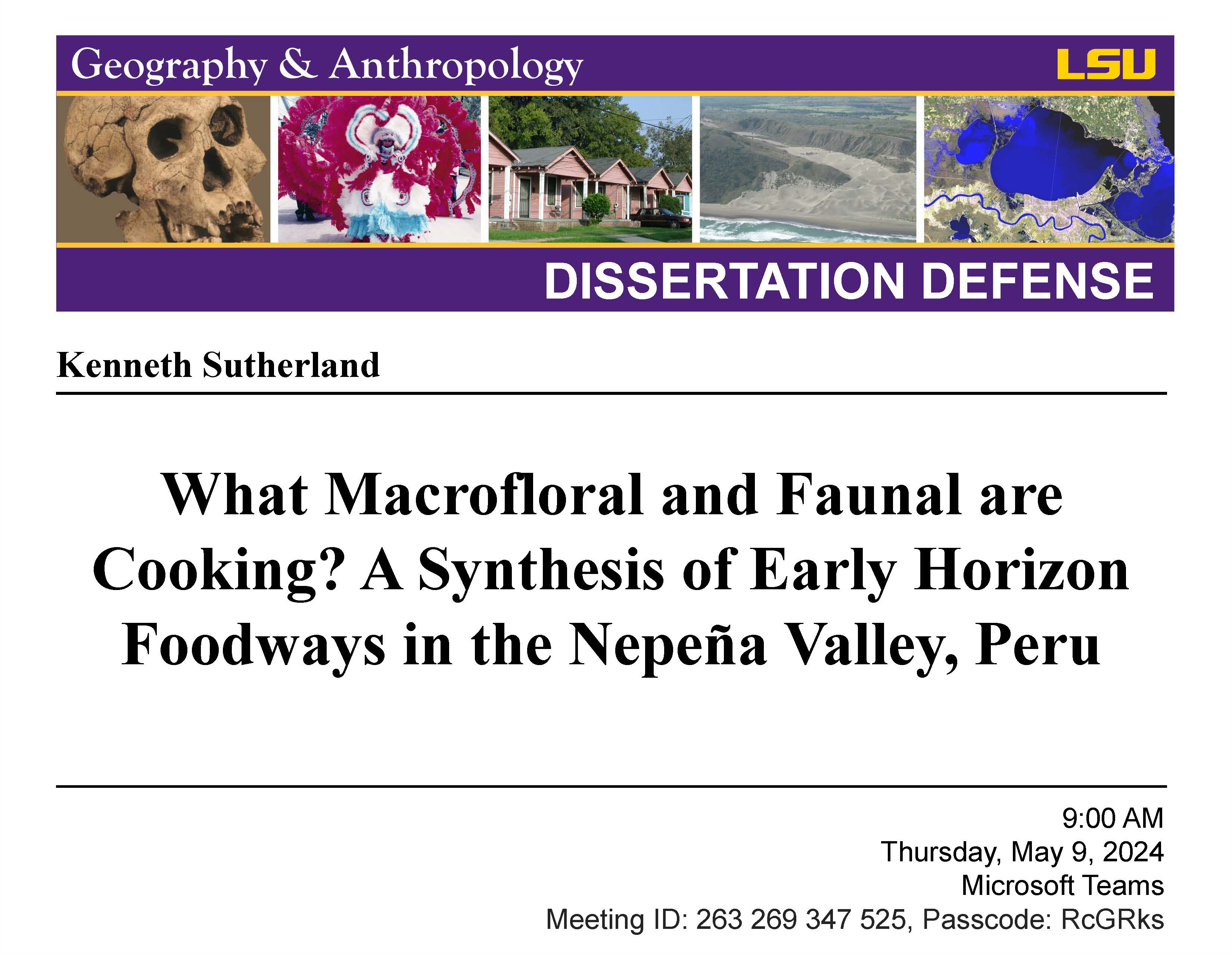
On May 9 (9am, Teams), Kenny Sutherland will defend a doctoral dissertation entitled “What Macrofloral and Faunal are Cooking? A Synthesis of Early Horizon Foodways in the Nepeña Valley, Peru.” Under the supervision of a committee composed of David Chicoine, Helen Regis, Sarah Franzen, Matthew Helmer, and Leslie Tuttle (Dean's Representative), Kenny's work integrates multiple floral and faunal proxies to reconstruct ancient foodways at Caylan (~600-200 cal BCE), an archaeological site in coastal Peru.
The public portion of the defense is open to the public and everyone is welcome to attend.
The article "Aerial, Surface, and Subsurface Multimodal Mapping in Coastal Peru: Insights from Cerro San Isidro, Moro Region, Nepeña Valley," co-authored by Kayla Golay Lausanne, David Chicoine, Jeisen Navarro Vega, and George F. Lau is now published and openly accessible in Advances in Archaeological Practices. The paper offers a step-by-step methodology for multimodal mapping based on our experience in coastal Peru.
Thanks to Sarah Herr, Christina Rieth, and Sjoerd van der Linde for their sound editorial guidance, as well as to all collaborators in Peru!
David Chicoine and Matt Helmer co-authored "Spatial Clustering, Focal Nodes and Neighborhood Organization in Early Horizon Peru: Comparative Perspectives from Caylán and Samanco, Nepeña Valley" for the volume Neighborhood and District Integration in the Andes and Mesoamerica edited by Gabriela Cervantes Quequezana and John Walden. The book, published by the Center for Comparative Archaeology of the University of Pittsburgh, is bilingual (Spanish and English) and open access.
Our chapter leverages data from long-term fieldwork in the Nepeña Valley of Peru to explore variations in the size, scale, and organization of neighborhoods as seen through the spatial clustering of architectural residential units, focal nodes, and overall settlement layouts.
Special thanks to Gabriela Cervantes Quequezana for the wonderful translation work, as well as to all our research collaborators in Peru.
¡Gracias!
Congratulations to Aja Palermo on the successful defense of their MA thesis entitled "If Threads Could Talk: Listening to Andean Textiles at the Louisiana State University Museum of Art." Upon the completion of minor revisions and submission to the graduate school, Aja is now set to graduate in May and explore career options in archaeology, art history, and museology.
Congratulations to Itzamara Ixta Pichardo on the successful defense of her thesis "The Ancient Occupation of the East Terrace at Cerro San Isidro, Moro District, Nepeña Valley, Peru." Following the completion of revisions suggested by the committee and submission to the graduate school, Itzamara will be set to graduate in May and continue her career in archaeology.
¡Felicidades!
The article "Aerial, Surface, and Subsurface Multimodal Mapping in Coastal Peru: Insights from Cerro San Isidro, Moro Region, Nepeña Valley," co-authored by Kayla Golay Lausanne, David Chicoine, Jeisen Navarro Vega, and George F. Lau has been accepted for publication in Advances in Archaeological Practices. The article should come out shortly in the second issue of volume 12. It offers a step-by-step methodology for multimodal mapping based on our experience in coastal Peru.
Congratulations to all collaborators!
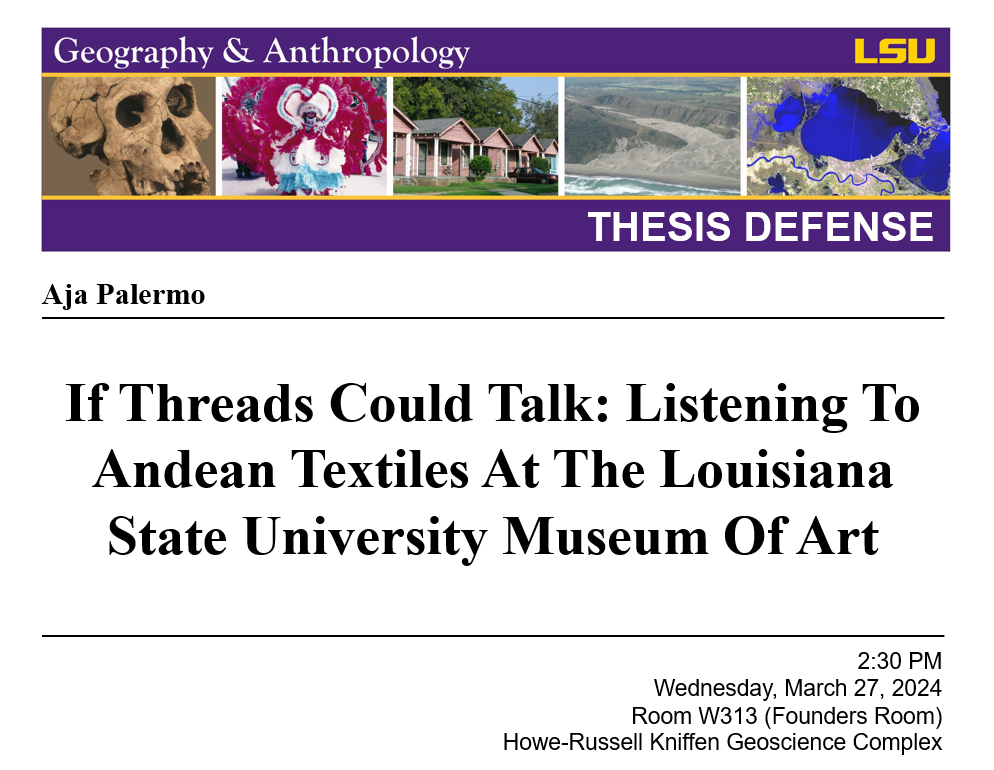
On March 27 (2.30pm, HRK W313) Aja Palermo will defend a thesis entitled "If Threads Could Talk: Listening to Andean Textiles at the Louisiana State University Museum of Art ." The public portion of the defense is open to anyone interested!
Aja's work, under the guidance of a committee composed of David Chicoine, Michael Mamp, Allison Young and Marianna Luquette, examines 16 ancient textile objects from Peru to shed light on weaving practices, the intricacies of collecting, and the role of archaeology in studying museum collections.
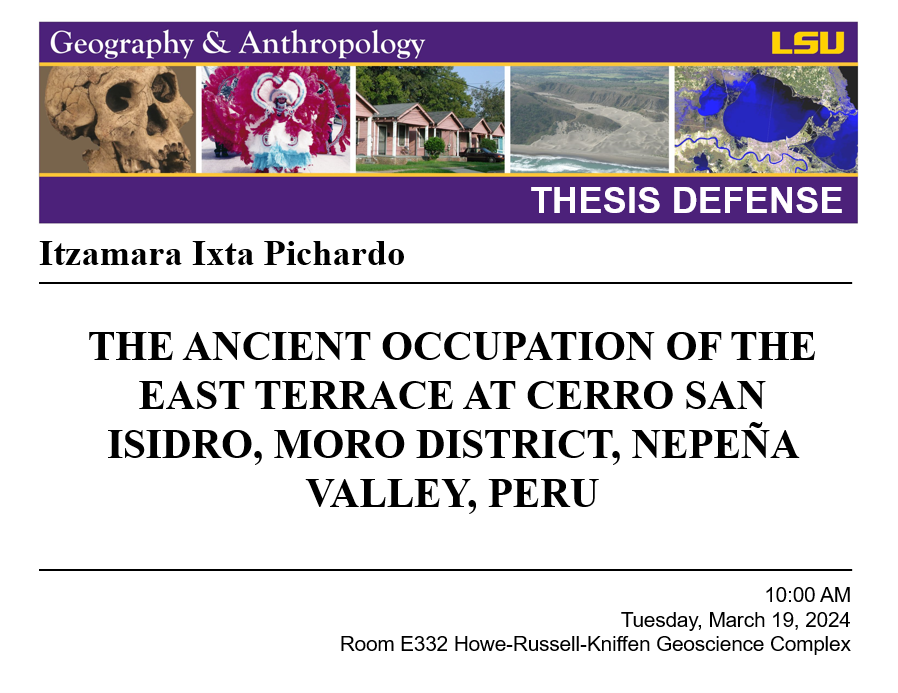
On March 19 (10am, HRK E332) Itzamara Ixta will defend her MA thesis entitled "The Ancient Occupation of the East Terrace at Cerro San Isidro, Moro District, Nepeña Valley, Peru." The public portion of the defense is open to anyone interested!
Itzamara's work, under the guidance of a committee composed of David Chicoine, Helena Fietz, and Matthew Helmer, examines ancient forms of domestic life and residential arrangements through time as seen through the archaeological evidence recovered at Cerro San Isidro.
Thanks to Benjamin Leonard, senior editor at Archaeology, a publication of the Archaeological Institute of America, for covering our research in "Divine Lords of the Andes: How a new generation of leaders claimed power in northern Peru by embracing cosmic connections to their ancestors." The article, published in the March/April 2024 issue, summarizes the discoveries made at Pashash and Cerro San Isidro between 2019 and 2022.
Check out Julia Johnston's review of "Edible People: The Historical Consumption of Slaves and Foreigners and the Cannibalistic Trade in Human Flesh" (2022, Berghahn Books) published in the AAA Anthropology Book Forum. Congratulations!
Julia is a graduate student in anthropology at LSU. She is currently completing coursework and developing a research project on Andean archaeology.
David Chicoine and Matt Helmer co-authored "Spatial Clustering, Focal Nodes and Neighborhood Organization in Early Horizon Peru: Comparative Perspectives from Caylán and Samanco, Nepeña Valley" for the volume "District and Neighborhood Sociopolitical Integration in the Andes and Mesoamerica" edited by Gabriela Cervantes and John Walden.
The book is currently in press with the Center for Comparative Archaeology of the University of Pittsburgh and should be out before the end of the year. The chapter explores variations in the size, scale, and organization of neighborhoods as seen through the spatial clustering of architectural residential units, focal nodes, and overall settlement layouts.
Many thanks to the editors and all research collaborators!
Congratulations to Haley Stuckey on graduating with honors today! She completed three bachelors (BA in Anthropology, BA in English [Creative Writing], BIS [Philosophy, History, Sociology], and wrote a wonderful thesis examining "Conducting Enchantment: Organized Sound and Ritual Spaces in Modern and Ancient Worlds." Her work was recognized by the Ogden Honors College yesterday at a luncheon held at the French House, and today Haley marched as part of the Commencement ceremonies held at the Pete Maravich Assembly Center.
Haley plans on pursuing graduate studies in archaeology and is currently applying to various graduate programs.
Congratulations to Madeline Blanchard who graduated from the MA program in anthropology in the Department of Geography & Anthropology at LSU. Madeline's thesis work explored ethnographic objects housed the LSU Museum of Natural Science, in particular Amazonian featherworks.
Madeline is currently looking for professional opportunities in archaeology, museum studies, and cultural heritage.
Congratulations to Kenny on the passing of his general exams! On December 4, 2023, he defended his proposal and discussed his written general exams with a committee composed of David Chicoine, Helen Regis, Sarah Franzen, Matthew Helmer and Leslie Tuttle.
Kenny is now ABD and set to complete the crafting of his dissertation examining multiple lines of evidences to shed light on human-animal-plant relations in the lower Nepeña Valley, Peru, during the first millennium BCE.
Congratulations to Haley Stuckey on the successful defense of her thesis "Conducting Enchantment: Organized Sound and Ritual Spaces in Modern and Ancient Worlds." The defense was held on November 8, 2023, under the supervision of a committee composed of David Chicoine, Chris Barrett, and Helena Fietz.
Drawing from “new materialist” theories (e.g., assemblage, Actor-Network), Haley explores the materiality and agency of sound and music in different contexts, from the ancient world (as seen through the archaeological excavations of prehistoric ceremonial architecture) through more recent examples (as seen for instance in 21st century live concerts and the online commodification of music). Haley’s argument hinges on the concept of “enchantment,” something that anthropologists (e.g., Alfred Gell) have used to break the binary between objects and subjects in many social sciences (e.g., anthropology of art), thus acknowledging the relational ways humans engage with their surroundings and are impacted by them. Drawing from a critical review of the anthropological and archaeological literature, Haley’s innovatively, and with great literary dexterity, investigates the ways through which sound and music can be considered as social agents who impact our lives, from our physical existence through our built settings, memories, and media.
Haley is currently completing a BA in Anthropology, a BA in English (Creative Writing), and a Bachelor in Interdisciplinary Studies with minors in Philosophy, History and Sociology. She is set to graduate in December 2023 with Honors and is currently working on her application materials for graduate programs.
On October 13-14, an international group of archaeologists, art historians, and curators gathered to explore "Sacred Sovereigns: Art, Divinity & Rulership in the Ancient Americas" as a part of a symposium organized by George F. Lau and David Chicoine, and sponsored by the AHRC, the Sainsbury Research Unit, and the University of East Anglia. The event was held in person at the Julian Study Centre Lecture Theatre and the Sainsbury Centre for Visual Arts on the University of East Anglia's Campus in Norwich, UK.
A group of internationally renowned scholars delivered 14 fascinating talks exploring various core themes and methodologies crucial to the study and understanding of ancient rulership and divinity in the ancient Americas. Case studies ranged from South America to Mesoamerica, the Isthmo-Colombia region and the Caribbean. Many thanks and congratulations to all presenters! Special thanks to Jeffrey Quilter and Steven Hooper for their willingness to discuss the contributions and for their invaluable insights.
Particular thanks ought to go to Helen Sibley, Lesley Snell, George F. Lau, Steven Hooper, Pat Hewitt, and the SRU post-graduate students for supporting the event and helping the organization and logistics.
Aja's academic path, recent field and lab experience, and thesis research have recently been featured on the Department of Geography & Anthropology's website.
Congratulations to Madeline Blanchard for successfully defending her thesis "Becoming Avian: Amazonian Featherworks from the John P. O'Neill Collections." Following the completion of revisions suggested by the committee, Madeline will be set to graduate at the Fall 2023 commencement ceremony on December 15.
On October 13-14, an international group of archaeologists, art historians, and curators will convene to explore Sacred Sovereigns: Art, Divinity & Rulership in the Ancient Americas as a part of a symposium organized by George F. Lau and David Chicoine, and sponsored by the AHRC, the Sainsbury Research Unit, and the University of East Anglia.
The event will be held in person at the Julian Study Centre Lecture Theatre and the Sainsbury Centre for Visual Arts on UEA's Campus in Norwich, UK. Core themes to be explored include: Polity & integration; Alterity & transcendence; Art, materiality & reception.
For any questions, please contact Lesley Snell by emailing lesley.snell@uea.ac.uk.
On September 29th, Dr. Kimberly Munro (PhD LSU 2018) will present on "The 2023 Excavations at the Cosma Archaeological Complex, Ancash – Peru. A Journey Down the Rabbit Hole into the Andean Late Preceramic" as part of the program of the 8th Annual Rocky Mountain Pre-Columbian Association Research Colloquium Current Research in the Ancient Americas to be held at the Denver Museum of Nature & Science. The paper will report on the discovery of a gallery system within one of the several platform structures documented at Cosma in the Upper Nepeña Valley.
Congratulations to Christopher Nicosia (PhD candidate LSU) on his recent appointment as Cultural Resources Manager and Tribal Historic Preservation Officer for the Twenty-Nine Palms Band of Mission Indians in California.
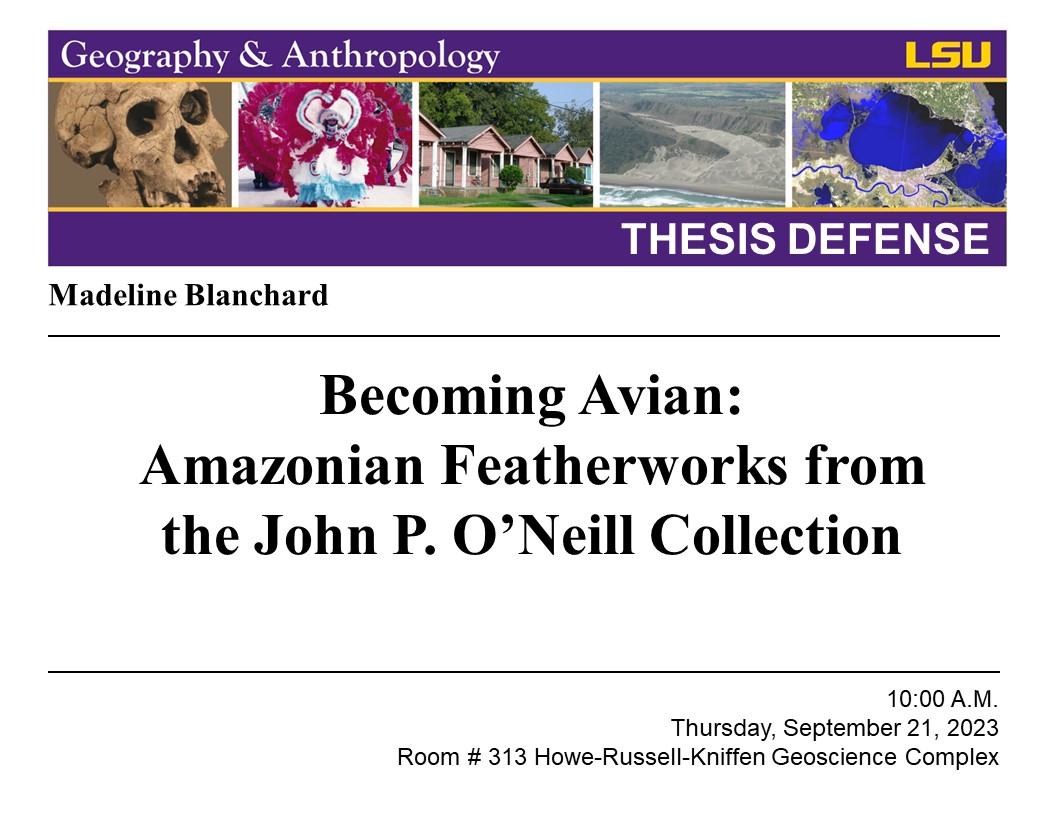
On September 21 (10am, HRK W313) Madeline Blanchard will defend her MA thesis entitled "Becoming Avian: Amazonian Featherworks of the John P. O'Neill Collection." Madeline's work, under the guidance of a committee composed of David Chicoine, Sarah Franzen, and Matthew Helmer, explores human-bird relations as seen through the materiality of the feather objects.
The public portion of the defense is open to anyone interested!

David Chicoine, Hugo Ikehara, and Koichiro Shibata collaborated on a chapter entitled "Beyond Chavín: The Millennium BC in the Nepeña Valley" for the volume "Reconsidering the Chavín Phenomenon in the Twenty-First Century" edited by Richard L. Burger and Jason Nesbitt and published by Dumbarton Oaks Research Library and Collection and Harvard University Press. The chapter offers a synthesis of recent archaeological finds from the lower Nepeña Valley in order to reconstruct the history of its communities during the first millennium BC.
Thanks to all our field collaborators, Drs. Burger and Nesbitt for the warm invitation to contribute to the volume, as well as to the the DO and HUP editoral staffs for their marvelous work!
Congratulations to Dr. Elizabeth Cruzado (PhD LSU 2021) on the publication of her most recent article in Volume 32 of the Boletín de Arqueología de la Pontificia Universidad Católica del Perú. The special volume explores the relationships between cultural heritage and archaeological practices in Peru.
Elizabeth's article, co-authored with Peruvian educator and community activist Gustavo Valencia, unpacks the co-creative initiatives deployed in Nivin, a small community in the middle Casma Valley on the north-central coast of Peru. The educational program is having a significant impact on the preservation of the archaeological heritage and a model for other archaeologists to emulate.
The contribution is based on Elizabeth's dissertation "The Ancient Occupation of Nivín, Casma, Peru: Co-Creating Heritage in Andean Archaeology" for which she won the Josephine A. Roberts LSU Alumni Association Distinguished Dissertation Award (social sciences and humanities category).
¡Felicitaciones!
Warm welcome to Julia Johnston (BA Anthropology [Honors], University of Notre Dame, 2023) who is joining our graduate program and Andean Archaeology Research Collective this fall.
Julia is interested in bioarchaeology, osteology, paleopathology, and museum studies. Prior to joining our program, she interned at the Field Museum and excavated at Gettysburg.
Congratulations to Kimbery Munro (PhD LSU 2018) on her recent appointment as Assistant Professor (Tenure-Track) in the Department of Sociology & Anthropology at New Mexico Highland University in Las Vegas, NM where she will instruct anthropology courses, supervise undergraduate and graduate students, and continue her research project at the intersection of religious studies, anthropology, geography, and archaeology in the Americas.
From July 3-28, MA student Aja Palermo participated in the Galway Archaeological Field School in Ireland.
Congratulations!
Congratulations to Aqsa "Amara" Khan for presenting her work on the role of climate change in the rise and fall of Harappan cities (2600-1900 BCE). The oral presentation was part of the 27th annual Summer Undergraduate Research Forum (SURF) held on July 28th in the LSU Student Union Royal Cotillion Ballroom.
Amara's "lightning talk" entitled "Climate Change Effects on the Harappan Civilization, and Its Relevance Today" offered a summary of her mining of the literature since June.
Well done!
On October 13-14, an international group of archaeologists will convene to explore Sacred Sovereigns: Art, Divinity & Rulership in the Ancient Americas as a part of a symposium organized by George F. Lau and David Chicoine, and sponsored by the AHRC, the Sainsbury Research Unit, and the University of East Anglia. The event will be held in person at the Julian Study Centre Lecture Theatre and the Sainsbury Centre for Visual Arts on UEA's Campus in Norwich, UK. Core themes to be explored include: Polity and integration; Alterity and transcendence; Art, materiality and reception.
For any questions, please contact Lesley Snell by emailing lesley.snell@uea.ac.uk.
Between October 24-28, Jeisen Navarro and David Chicoine, directors of the Proyecto Arqueológico Cerro San Isidro, will deliver a talk exploring "Ritual y culto a los ancestros en Cerro San Isidro, Distrito de Moro, Valle de Nepeña" as part of the X Congreso Nacional de Arqueología to be held in person in Lima and organized by the Peruvian Ministerio de Cultura.
As part of LSU's Ronald E. McNair Research Scholars program, Aqsa "Amara" Khan, a geography major, is researching the impact of climate change on the development of ancient Harappan cities. The settlements, which developed between 2600 and 1900 BCE during the Mature Harappan Phase, are associated with what archaeologists have called the Indus River civilization.
Amara's work, under the supervision of Professor David Chicoine, focuses on the review of the existing literature with the objective of weighing the potential impact of climate in the shifting human-environmental dynamics including agriculture and other economic activities.
Amara's research, scheduled for the summer of 2023, will culminate with an oral presentation and a written essay at the end of July.
From May 15-June 1, MA student Itzamara Ixta assisted in excavations at Kisatchie National Forest (Pineville, LA) as part of an archaeology field school organized by the University of Louisiana at Lafayette in collaboration with the Louisiana Public Archaeology Lab and the Kisatchie Heritage Program. The project is under the guidance of Drs. Erlend Johnson (field director), Mark Rees (principal investigator), and Matt Helmer (Kisatchie's heritage program manager).
From May 21-26, MA student Aja Palermo participated in Penn Museum’s intensive summer course on Andean textile studies. The program, under the guidance of textile specialist Dr. Anne Tiballi, was held at the Center for the Analysis of Archaeological Materials (CAAM) located on the campus of the University of Pennsylvania in Philadelphia. This experience will greatly benefit Aja in developing a thesis research on Andean textiles housed at the LSU's Museum of Art.
Congratulations!
Congratulations to Dr. Jacob Warner (PhD LSU 2021) on presenting his research on "Assessing the utility of trace elements (Sr/Ca, Mg/Ca, and Ba/Ca) as potential environmental proxies in Donax obesulus" as part of the 6th International Sclerochronology Conference held in Tokyo, Japan, from May 22-25.
Jacob is currently Assistant Professor in the Department of Geography and Environmental Sustainability at SUNY Oneonta.
Course scheduling for next semester is now open. For Fall 2023, I will instruct ANTH2050 World Archaeology and ANTH4025 Archaeology of Foodways. You can find sample syllabi under the "Teaching" tab on this website, but feel free to email me if you have any questions. I hope you can join us!
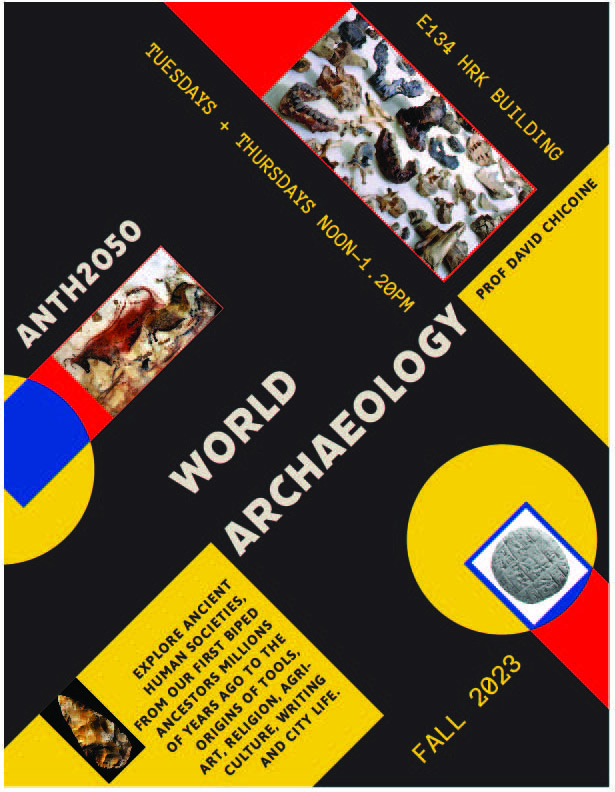
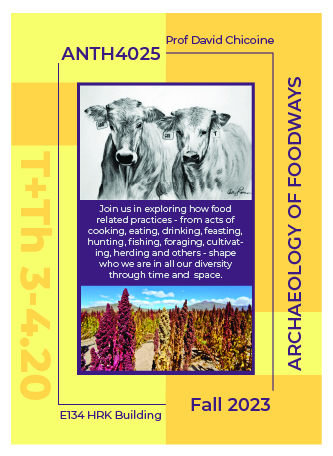
LSU Andean archaeologists and collaborators presented their work at the 88th Annual Meeting of the Society for American Archaeology held in Portland, Oregon from March 29 through April 2.
Kimberly Munro (PhD LSU 2018) presented a poster on "The Road to Rayan is Paved with Good Intentions" as part of a session on "Landscape Archaeology."
Kayla Golay Lausanne (PhD candidate McMaster University) and David Chicoine crafted a poster on "Multimodal Mapping at Cerro San Isidro, Nepeña Valley, Peru" within a session on "Remote Sensing."
Congratulations to all!
Congratulations to G&A alumna Beverly Clement (MA Anthropology 2012) on her recent appointment as Associate Archaeologist for the Sisters Ranger District!
David Chicoine, Hugo Ikehara, and Koichiro Shibata wrote "Beyond Chavín: The Millennium BC in the Nepeña Valley" for the volume Reconsidering the Chavín Phenomenon in the Twenty-First Century edited by Richard L. Burger and Jason Nesbitt and currently in press with Dumbarton Oaks Research Library and Collection, and Harvard University Press. The chapter offers a synthesis of recent archaeological finds from the lower Nepeña Valley to reconstruct the history of its communities during the first millennium BC.
Thanks to all our field collaborators, as well to the editors for their marvelous work!
Congratulations to G&A alumnus Matt Helmer (MA Anthropology LSU 2011, PhD UEA 2015) on his recent promotion to Heritage Program Manager and Tribal Liaison at the Kisatchie National Forest in Pineville, Louisiana! His responsibilities include managing more than 5,000 archaeological sites and developing initiatives to preserve and value local indigenous heritage and knowledge.
Congratulations to LSU G&A alumnus Matt Helmer (MA Anthropology LSU 2011, PhD UEA 2015) on his recent co-authored work exploring "A centennial perspective on archeological research trends and contemporary needs for a vanishing Mississippi Delta." The article, co-authored with Drs. Elizabeth Chamberlain (Wageningen University) and Jayur Metha (Florida State University), and openly accessible in the Holocene, reviews the history of archaeological research and land loss in the Mississippi Delta and provides perspectives on the future of management strategies.
Congratulations to all collaborators!
Congratulations to LSU G&A alumna Dr. Elizabeth Cruzado (PhD LSU 2021) for contributing a poster exploring "Perspectives over the Longue Durée in the Nivín Region: Architecture, Material Culture and Chronology of the Middle Section of the Casma Valley" to the 39th Northeast Conference on Andean and Amazonian Archaeology and Ethnohistory Annual Meeting organized by Richard Burger, Lucy Salazar and Corey Herrmann, and held at Yale University on November 19-20.
¡Felicidades!
Dr. Kimberly Munro (PhD LSU 2018) presented on "Water Rituals, Fire Temples and the Late Preceramic – A Case Study at the Cosma Archaeological Complex, Upper Nepeña Valley, Peru" as part of the 7th Annual Rocky Mountain Pre-Columbian Association Research Colloquium Current Research in the Ancient Americas held at the Denver Museum of Nature & Science.
Congratulations!
Congratulations to LSU alumnus Dr. Matt Helmer (MA LSU 2011) on his recent co-authored work exploring "National Forest Visitation Preferences and Avenues to Participation for Urban Hispanic Recreationists in the Portland Metropolitan Area." The article is published in open access format in the Journal of Forestry.
Matt currently works as the Heritage Program Manager for Kisatchie National Forest and is Adjunct Assistant Professor in the Department of Geography & Anthropology at LSU.
Dr. Kimberly Munro (PhD LSU 2018) co-chaired a session exploring "Student Equity and Achievement (SEA) through Universal Design for Learning (UDL): Different not Deficient" held at the Colorado Community College System (CCCS) Education Excellence Conference. Congratulations!
Kimberly currently works at Otero College where she teaches Cultural Anthropology and Anthropology of Religion, co-directs a summer archaeological field course, and oversees undergraduate research projects and experiential learning opportunities.
David Chicoine and Dr. Jacob Warner (PhD LSU 2021) co-authored "Gathering Salinar Houses: Platforms-as-Assemblages in Ancient Coastal Peru" for the volume From House Societies to States: Early Political Organization, from Antiquity to the Middle Ages edited by Juan Carlos Moreno García (2022, Oxbow Books). The chapter applies assemblage theory to the analysis of the construction and renovation of raised platforms by groups associated with Salinar, an archaeological phenomenon that emerged in several valleys of the north coast of Peru following the dissolution of the Chavín and Cupisnique influences around 500 BCE.
Thanks to Juan Carlos Moreno for the invitation to contribute and the fine editorial guidance!
Congratulations to PhD candidate Amy Hair for successfully passing her general exams and defending her proposal on "Osteons and Orthodoxy: Cortical Histology at Tipu, Belize and its Implications for Religious, Economic, and Social Negotiations in the Maya Colonial Era." Amy is now ABD and set to write her dissertation!
Congratulations to Dr. Elizabeth Cruzado (PhD LSU 2021) on her recent hire as Adjunct Lecturer in the Department of Anthropology at SUNY Oneonta where she will be teaching various courses including Prehistoric World Cultures and North American Indians. Felicidades!
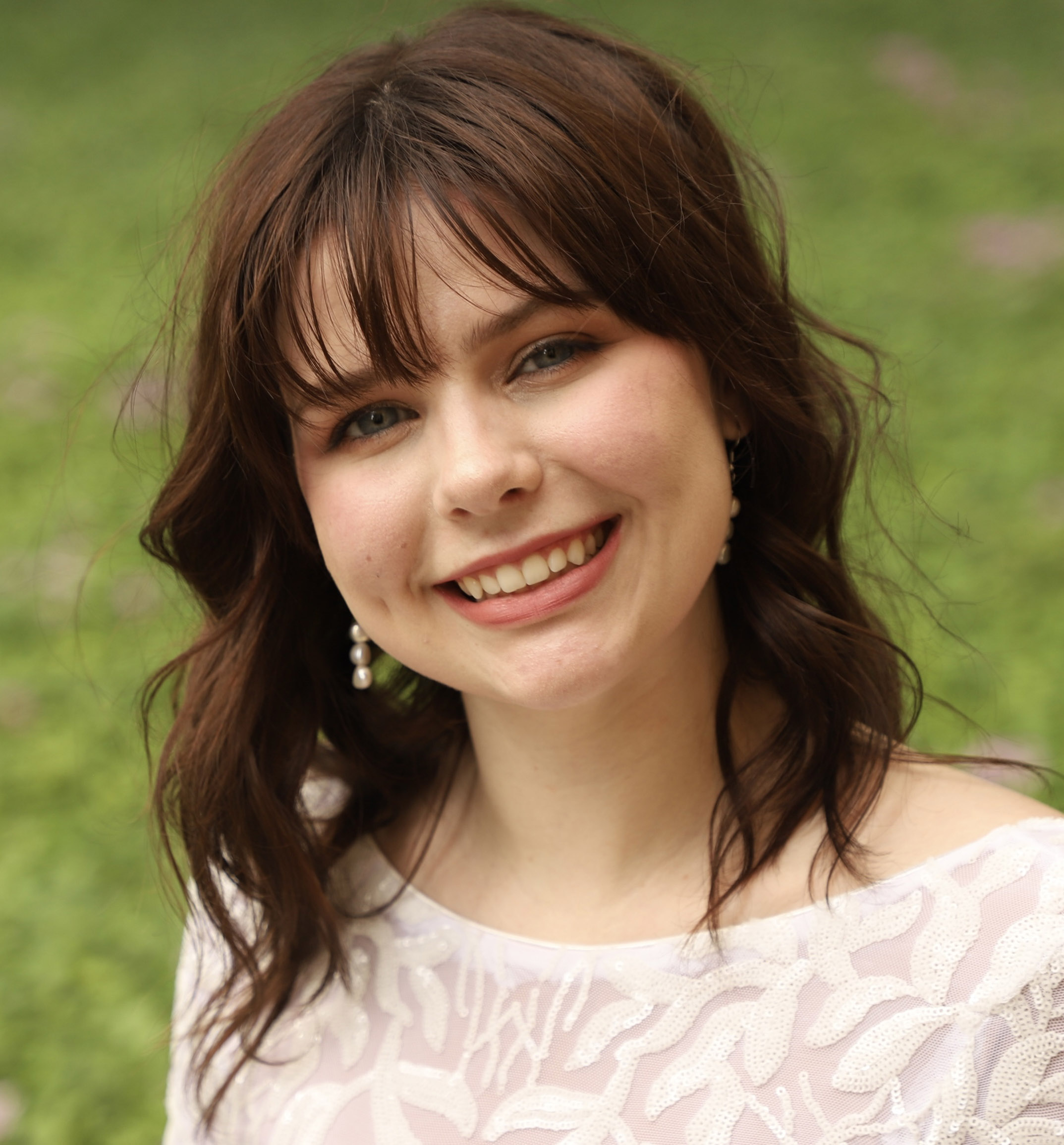
The LSU's Andean Archaeology Research Collective and Department of Geography & Anthropology are happy to welcome Aja Palermo (BIS LSU 2022).
Aja is starting the MA Program in Anthropology after participating in LSU's 2022 Coastal Sustainability Studio Summer Internship Program.
Aja has interests in archaeology, material culture, gender, food, and museum studies, and as an undergraduate, they studied anthropology, art history, and chemistry.
Welcome!
Congratulations and thanks to the Asociación Caminemos Unidos (ACU) and the Museo Arqueológico de las Tecnologías Andinas de Moro for producing a documentary film on the 2022 season of the Cerro San Isidro project. The video, entitled REPORTAJE DEL PROYECTO DE INVESTIGACIÓN CERRO SAN ISIDRO (PIACSI) DEL DISTRITO DE MORO, features footage from the field and laboratory activities, as well as interviews with different project members. It was released as part of celebrations highlighting the 7th anniversary of the Museo Arqueológico de las Tecnologías Andinas. Special thanks to Arnold Ochoa, Franz Veramendi, and José Saavedra for their initiative and hard work.
¡Felicidades y gracias!
Congratulations to Dr. Jacob Warner (PhD LSU 2021) on his recent hire as Assistant Professor (Tenure-Track) in Geography and Environmental Sustainability at SUNY Oneonta in New York. The position is part of a cluster hire conducted by the university focusing on implementing the United Nations’ Sustainable Development Goals in New York. In this new chapter of his career, Jacob will instruct courses on various environmental issues, train students in the lab and the field, and pursue his research program at the intersection of paleoclimatology, geoarchaeology, and environmental studies.
Thanks to geoarchaeologist Kayla Golay Lausanne (PhD candidate, McMasterU) and all the participants involved in the Ground Penetrating Radar workshop held on July 16 in Moro, Peru. The event explained the use and applications of GPR technology, and involved a hands-on component.
The workshop is part of broader collaborative efforts between the Asociación Caminemos Unidos and the Proyecto de Investigación Arqueológica Cerro San Isidro to make archaeology relevant to Morinos and other Peruvians.
Thanks to all!
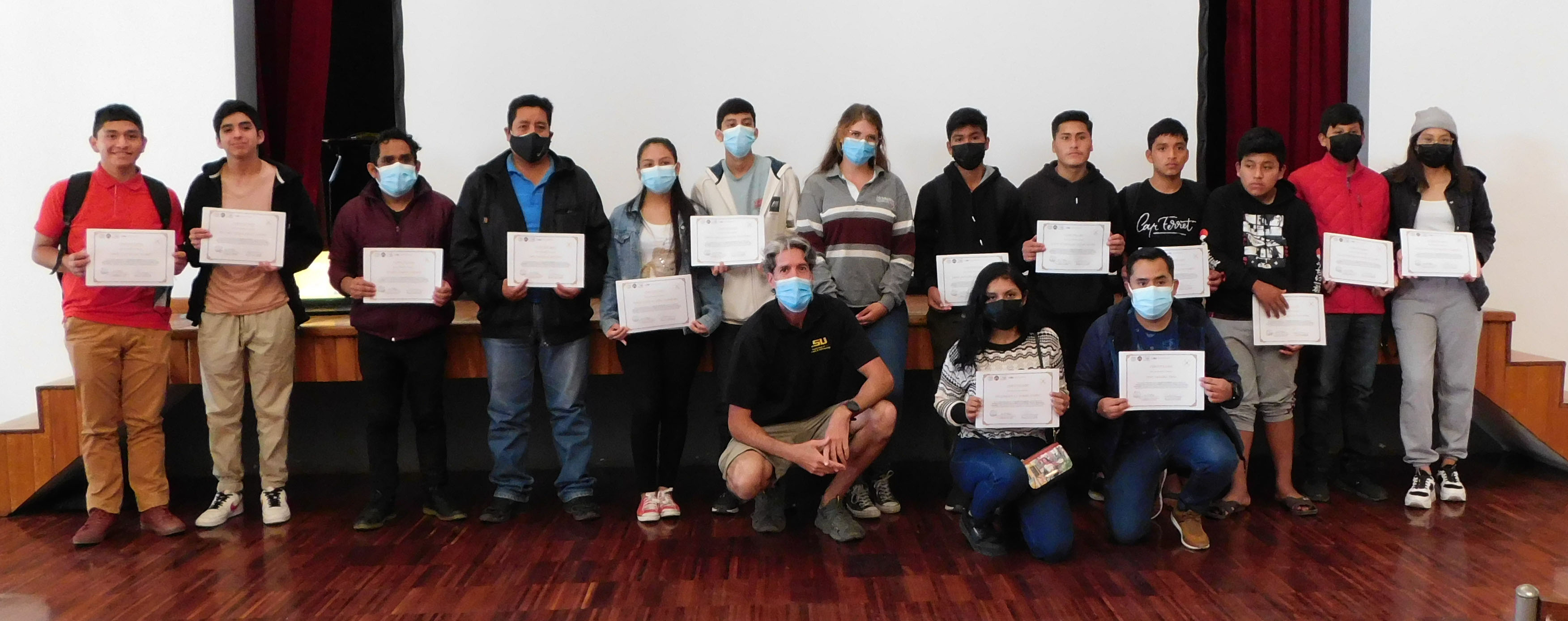
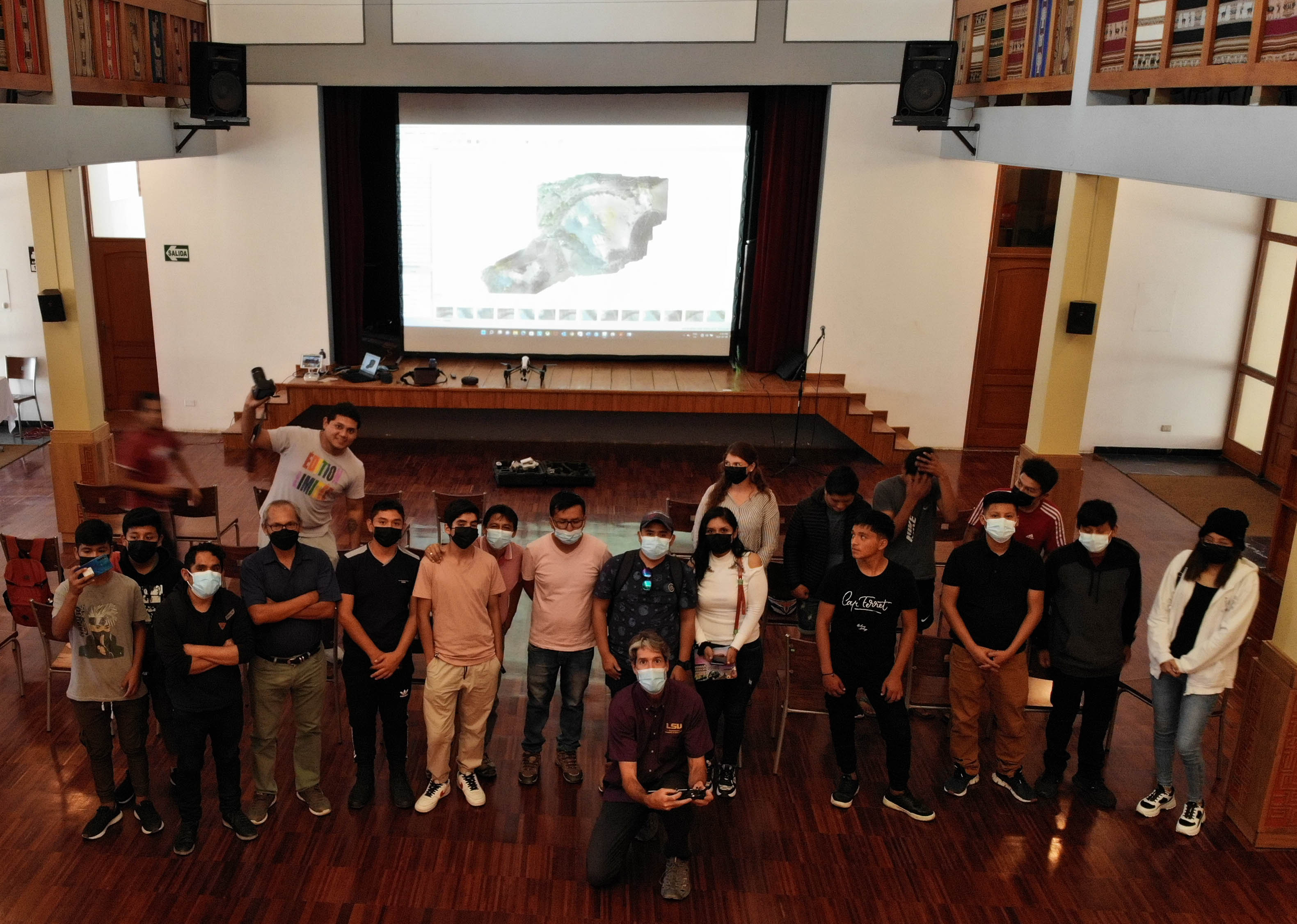
In collaboration with the Asociación Caminemos Unidos (ACU) and the Museo Arqueológico de las Tecnologías Andinas, our team kicked off its 2022 outreach program with a workshop exploring the use of drone technology in archaeology. The hands-on event, held on July 9 at ACU, focused on the use of drone imagery in mapping topography and understanding archaeological contexts. Thanks to Kayla Golay Lausanne (PhD candidate, McMasterU) for her help and support, as well as to all the participants for their time and interest!
Upcoming events are planned for the remainder of July including workshops on GPR surveying and ceramic analysis in archaeology.
After a hiatus forced by the Covid-19 pandemic, the field activities of the Proyecto de Investigación Arqueológica Cerro San Isidro have resumed. Our team is in Moro, Peru, to continue fieldwork and outreach activities.
Many thanks to the Ministerio de Cultura del Perú for approving and supervising the 2022 activities, the Asociación Caminemos Unidos and the Museo Arqueológico de las Tecnologías Andinas for their warm hospitality, and the NSF for the financial support.
The San Isidro research is part of a broader program exploring the rise of divine lordships in northern Peru in collaboration with Dr. George F. Lau (University of East Anglia).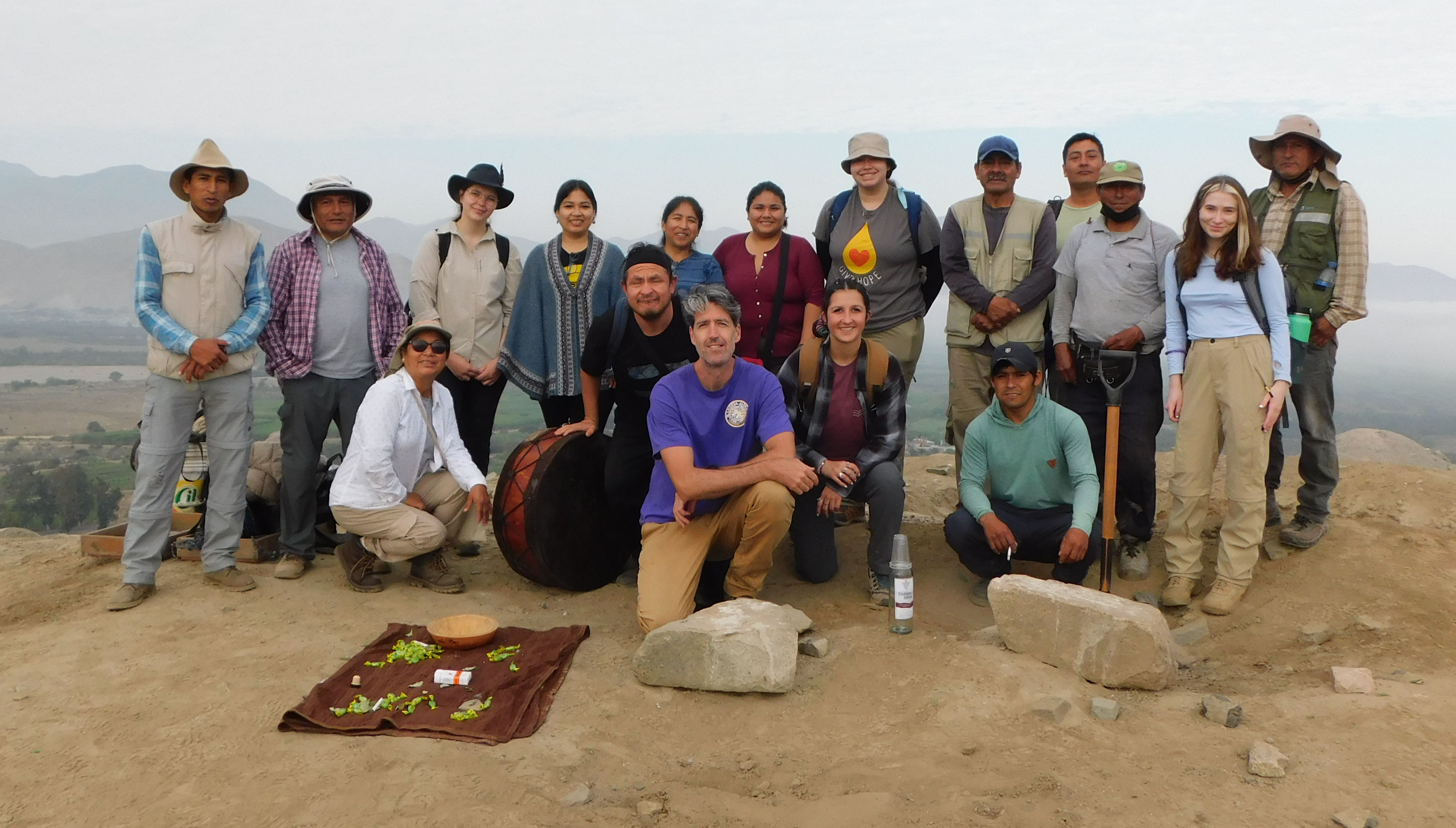
Congratulations to Dr. Kimberly Munro (PhD LSU 2018) and Elizabeth Cruzado (PhD LSU 2021) on their recent contribution to the online symposium Aporte de las mujeres investigadoras en la arqueología de Ancash sponsored by the Proyecto Sechín and the Instituto Peruano Cultural Deportivo Yaguar. The event was organized by Mónica Suárez (director of the Proyecto Sechín) to celebrate the 85th anniversary of the discovery of Cerro Sechín.
Kimberly and Elizabeth video presentations drew from their dissertation field research in Ancash, at Cosma and Nivín, respectively. ¡Felicidades!
The research article "The Rise of Native Lordships at Pashash, A.D. 200–600, North Highlands of Ancash, Peru" co-authored by George Lau, Milton Lujan, Jacob Bongers, and David Chicoine is now published and openly accessible in the Journal of Field Archaeology.
Thanks to all collaborators!
Congratulations to MA student Itzamara Ixta on her recent publication of the book review "The Poetics of Processing: Memory Formation, Identity, and the Handling of the Dead" in the Anthropology Book Forum of the American Anthropological Association.
Thanks and congratulations to Dr. Jacob Warner (PhD LSU 2021) for presenting on "The El Niño-Southern Oscillation and its Impacts on Coastal Peruvian Settlements ~2.4 ka: Perspectives from Two Short-Lived Bivalve Species" at the Open Science Meeting held between May 16 and 30. The paper, co-authored by Warner, DeLong, Chicoine, Andrus, Thirumalai & Wanamaker Jr., was included in Session 18 entitled “Using High-Resolution Marine Archives to Investigate Marine Climate, Marine Environment, and Maritime Societies Through the Holocene.” Well done!
Congratulations to Cecil Craig for graduating with a Bachelors of Arts in Anthropology, a Bachelor in Interdisciplinary Studies, and a Distinguished Communicator Certificate offered by the Communication across the Curriculum (CxC) initiative. Well done!
Cecil is currently looking to deploy his versatile skills and build a career in museology, archaeology, cultural heritage, and/or education.
Two articles exploring "Plants and Diets in Early Horizon Peru: Macrofloral Remains from Rehydrated Fecal Samples at Caylán" and "Taxonomic Analyses of the Vertebrate Faunal Remains from Caylán, Peru" are now published in Andean Past 13 and available in open access format.
Thanks to all collaborators, the Louisiana Board of Regents for the financial support, as well as to Monica Barnes, Dan Sandweiss, Ruth Anne Phillips, and David Fleming for the excellent editorial work!
Several current and former LSU Andeanists presented at the 87th Annual Meeting of the Society for American Archaeology held in Chicago from March 30 to April 3.
PhD candidate Christopher Nicosia (photo below) prepared a poster detailing his dissertation research and entitled "Preliminary Results of the Spatial Analysis of Nonspecific Stress in Ancient North America." Chris is tracking changes in nonspecific etiologies using hot spot analysis, multiple regression models of geographic and environmental variables, and spatial analysis of etiologies.
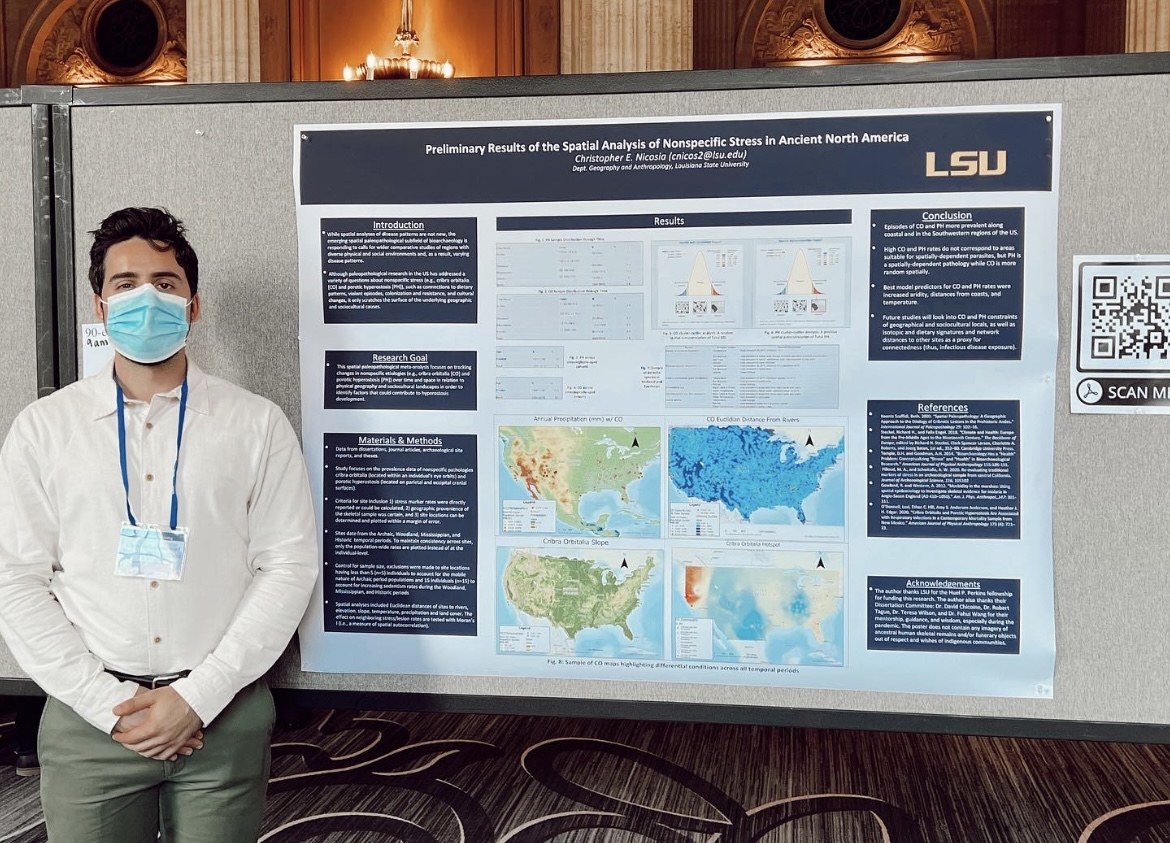
LSU alumna Kimberly Munro (PhD LSU 2018) (photo below), along with David Chicoine and George Lau, read a paper on "Roads as Bridges: Assembling Communities and Borderlands over the Longue Durée in Western Ancash" as part of a symposium on "Borderlands of the Andes" organized by Amedeo Sghinolfi, Ryan Smith and Patrick Mullins. The paper explored ancient roads and their connected networks as more-than-human actors. Conceptualizing human settlements and routes as agentive nodes of interaction sheds light on three moments in Ancash prehistory: (1) the Late Preceramic, (2) the Early Horizon, and (3) the Early Intermediate period. By taking a comparative longue durée approach, the case studies bring insights into longitudinal shifts in mobilities, community building, and territoriality on the western slopes of the Cordillera Negra.
Kimberly also co-authored a paper with Rebecca Bria and Matthew Piscitelli on "Temples in Process, Not Periods: Reevaluating Narratives of Early Community Practice and Interaction across North-Central Peru." Their paper was included in a symposium on "Leveraging Radiocarbon in the Central Andes" organized by Daniel Contreras, Erik Marsh and Kurt Rademaker.

Matt Helmer (MA LSU 2011, PhD UEA 2015) (photo below) participated in a discussion on "Soundscape Archaeology: Sound and Experience in Heritage Research" organized by Kristy Primeau and Miriam Kolar. Matt presented and discussed his acoustics research and experiments in coastal Peru.

David Chicoine and PhD student Amy Hair prepared a poster on "Photogrammetry and 3D Modeling at Cerro San Isidro, Nepeña Valley, Peru." The piece detailed the results of the photogrammetric reconstructions and 3D modeling of the excavation contexts and complete objects. Based on stratigraphic, stylistic and radiometric data, the deposits document a long and complex occupation history between the Late Formative (or Early Horizon) and the Late Intermediate period. The 3D models highlight the value of photogrammetry as a method of recording and visualizing archaeological deposits and artifacts.
Congratulations to all for some great research and for representing LSU so well!
Congratulations to PhD student Amy Hair for presenting at the 49th Annual North American Meeting of the Paleopathology Association held in Denver on March 22 and 23. Amy's poster, entitled "Geospatial distribution of craniosynostosis at Tipu, Belize, and its implications for burial patterning on the colonial frontier (AD 1543-1707)," detailed some of her ongoing work on the bioarchaeology of Precolumbian and earlier colonial Americas.
Congratulations to Elizabeth Cruzado (PhD LSU 2021) on winning the Josephine A. Roberts LSU Alumni Association 2022 Distinguished Dissertation Award in Arts, Humanities & Social Sciences for her work entitled "The Ancient Occupation of Nivin, Casma Peru: Co-Creating Heritage in Andean Archaeology."
Congratulations to Dr. Jacob Warner (PhD LSU 2021) and Aleksa Alaica for their article on Contextualizing the influence of climate and culture on bivalve populations: Donax obesulus malacology from the north coast of Peru published with open access in the Journal of Island and Coastal Archaeology.
Congratulations to LSU alumna Dr. Elizabeth Cruzado (PhD LSU 2021) on her recent hire as an archaeological specialist at SURA in Baton Rouge!
Congratulations to LSU alumnus Dr. Jacob Warner (PhD LSU 2021) on his recent hire as postdoctoral researcher at the Schubert Lab of the University of Louisiana-Lafayette. Jacob will assist Dr. Brian Schubert in completing research funded by a National Science Foundation Paleo Perspectives on Climate Change (P2C2) grant. The project uses stable isotope signals recovered from Eocene-age mummified wood remains excavated in Arctic Canada to reconstruct the temperature of the region ~54 million years ago. Paleoclimatologists are especially interested in this time interval because it could represent an analog for future conditions in the Arctic.
Congratulations to Monica Fenton (MA in Anthropology), Elizabeth Cruzado (PhD in Geography & Anthropology), and Jacob Warner (PhD in Geography & Anthropology) who received their diplomas at LSU Fall 2021 commencement.
Felicidades to all!
Monica Fenton (MA LSU 2021) wrote a chapter on "The Construction of Gender in Graves at Sitio Conte" in ancient Panama. The chapter was included in a volume on Pre-Columbian Central America, Colombia, and Ecuador: Toward an Integrated Approach edited by the late Colin McEwan and John W. Hoopes and published by Dumbarton Oaks and Harvard University Press. In the same volume, Monica co-authored another chapter with Clark Erikson on "Who Is the Chief? The Central People of Burial 11, Sitio Conte." Both contributions explore mortuary contexts of the Coclé culture of ancient Panama.
Jacob Warner, in collaboration with Kristine DeLong and David Chicoine, presented on "Trace Element Ratios (Sr/Ca, Mg/Ca, and Ba/Ca) in the Short-Lived Bivalve Donax obesulus: Potential Environmental Proxies?" at the American Geophysical Union (AGU) fall meeting in New Orleans.
The research article Investigating the influence of temperature and seawater δ18O on Donax obesulus (Reeve, 1854) shell δ18O co-authored by Jacob Warner, Kristine DeLong, David Chicoine, Kaustubh Thirumalai, and C. Fred T. Andrus has been published online (open access) in the peer-reviewed journal Chemical Geology.
Congratulations to all collaborators!
The research article Enchantment in ancient Peru: Salinar period murals and architecture has been published online in the peer-reviewed journal World Art.
Many thanks to George F. Lau for his sound editorial work, the external reviewers for their insightful suggestions, as well as all research collaborators in Peru!
LSU alumna Kimberly Munro (PhD 2018) delivered a talk on "Who Says You Can’t “Go Home?” Rethinking Religious Networks towards Formative Interactions in the Andes" as part of the online symposium "Formative Interactions in the Central Andes" organized by Michelle Young and Justin Jennings and sponsored by Vanderbilt University and the Royal Ontario Museum. Her paper uses data from her dissertation excavations at the ceremonial complex of Cosma in the upper Nepeña Valley to discuss broader patterns of religious networks in ancient Peru. Congratulations Dr. Munro!
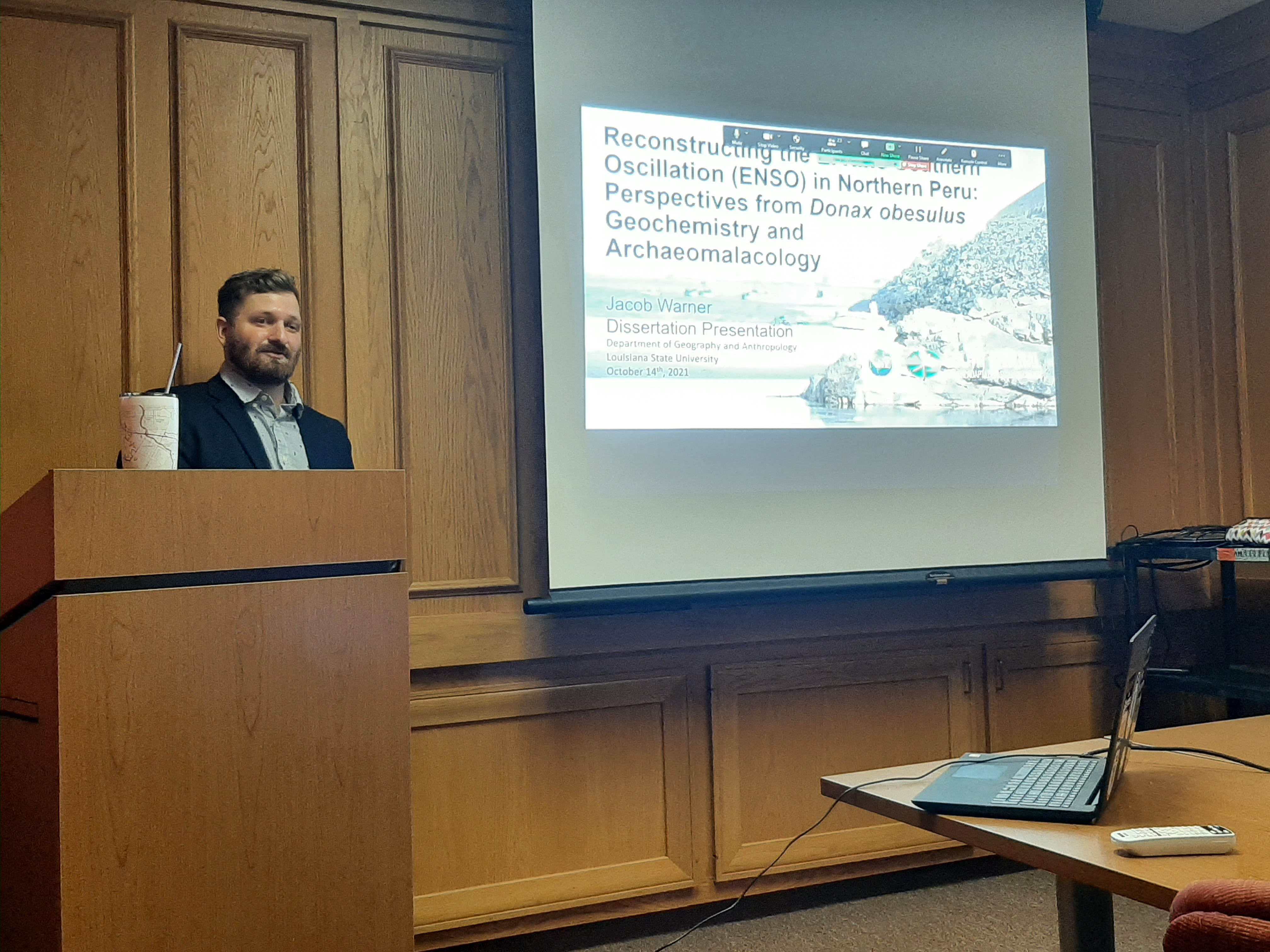
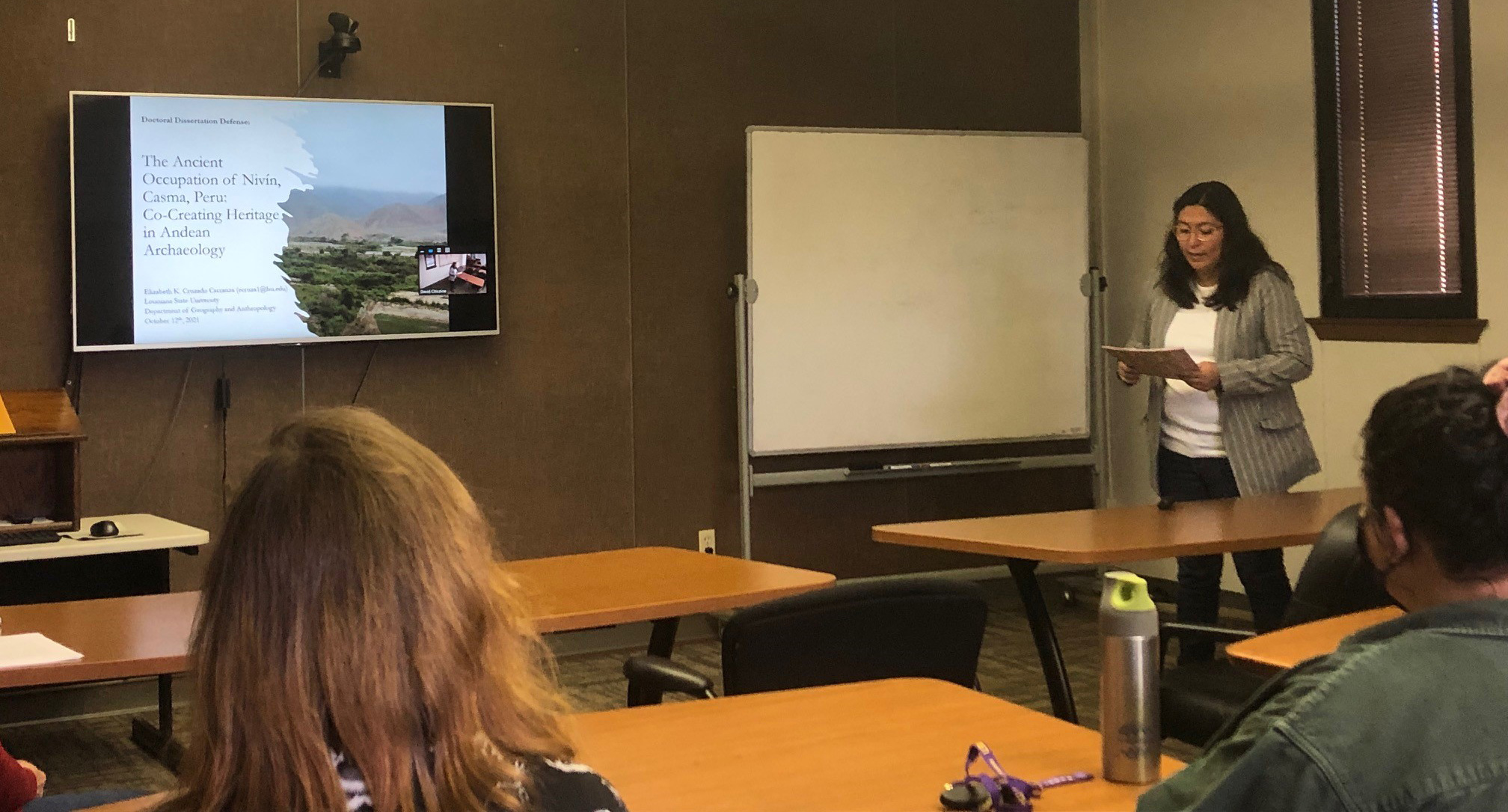
Congratulations to Monica for successfully defending her thesis "What the Shell? The Zooarchaeology of Cerro San Isidro, Peru." She is now ready to graduate at the Fall 2021 commencement ceremony on December 17.
